Paul van Yperen's Blog, page 381
May 29, 2015
Het meisje met de blauwe hoed (1934)
Het meisje met de blauwe hoed/The girl with the blue hat (1934) is a Dutch 'army film', directed by Austrian director Rudolf Meinert. Stars are Roland Varno, Truus van Aalten and Lou Bandy. The film is an adaptation of the book Het meisje met de blauwe hoed by Johan Fabricius and was remade in 1972 as a popular television series with colour and new songs.
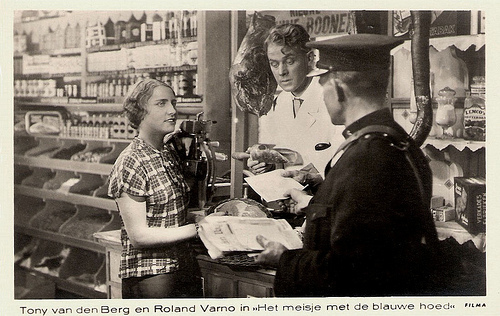
Dutch postcard by M. B.& Z. (M. Bonnist & Zonen, Amsterdam). Photo: Filma.Publicity still for Het Meisje met de Blauwe Hoed/The girl with the blue hat (Rudolf Meinert, 1934) with Tony van den Berg and Roland Varno .
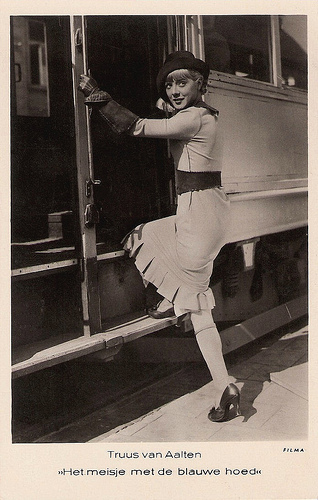
Dutch postcard by M. B.& Z. (M. Bonnist & Zonen, Amsterdam). Photo: Filma. Publicity still for Het meisje met den blauwen hoed/ The Girl with the Blue Hat (Rudolf Meinert, 1934) with Truus van Aalten . Collection: Egbert Barten. Comment by Ali Gardener at Flickr : "It looks like taken very spontaneous and still so perfectly posed! I like also the shadow of the shoes and all those splendid details."
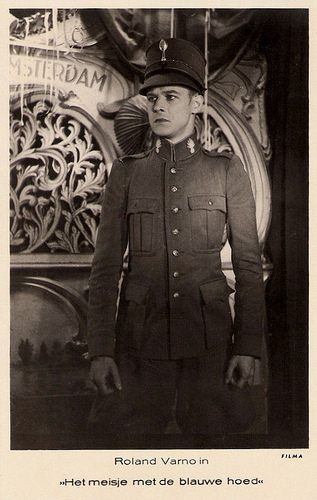
Dutch postcard by M. B.& Z. (M. Bonnist & Zonen, Amsterdam). Photo: Filma. Publicity still for Het meisje met de blauwe hoed/The Girl With the Blue Hat (Rudolf Meinert, 1934) with Roland Varno . Collectie: Egbert Barten.
Unusual for the Netherlands
Het meisje met de blauwe hoed/The girl with the blue hat was an unusual production for the Netherlands in the 1930s. It was the first production by Filma, the film production company of 27 years old Wil Tuschinski, son of cinema chain owner Abraham Tuschinski. For the first time, a moving camera was used in the Cinetone Sound Film studios in Amsterdam. The production costs amounted to 100,000 guilders - a record for the Dutch film industry at the time.
The three stars were also interesting. Dutch-born actor Roland Varno (1908-1996) is best known for his role as one of the schoolboys in Josef von Sternberg's Der blaue Engel/The blue angel (1930). He appeared in several German and Dutch films of the early 1930s and then moved to Hollywood, where he made a film with Greta Garbo , As You Desire me (George Fitzmaurice, 1932). However, he mostly worked in Hollywood as a character actor, often in B-pictures.
The female leading role was played by another Dutch film star with a career abroad, Truus van Aalten (1910-1999). She starred in 29 European films during the 1920s and 1930s. She made most of them in Berlin and Vienna, and Het Meisje met de Blauwe Hoed/The girl with the blue hat was the only film she made in the Netherlands.
Singer and entertainer Lou Bandy (1890-1959) played a dual role in Het meisje met de blauwe hoed/The girl with the blue hat as Toontje and as himself. Bandy was one of the most popular artists of The Netherlands between the two world wars. His songs Zoek de zon op (Look for the sun) and Louise zit niet op je nagels te bijten (Louise, don't bite your nails) became Dutch evergreens. In this film, Bandy sings the songs In de petoet (In the brig) and Vaste verkering (Steady dating) which soon became hits in the Netherlands.
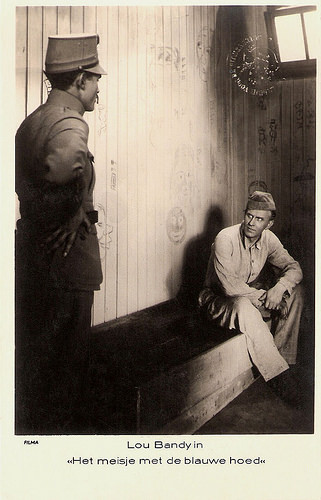
Dutch postcard by M. B. & Z. (M. Bonnist & Zonen, Amsterdam). Photo: Filma. Publicity still for Het Meisje met de Blauwe Hoed/The girl with the blue hat (Rudolf Meinert, 1934) with Lou Bandy .
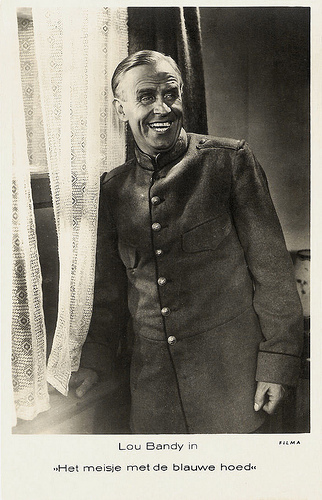
Dutch postcard by M. B. & Z. (M. Bonnist & Zonen, Amsterdam). Photo: Filma. Publicity still for Het Meisje met de Blauwe Hoed/The girl with the blue hat (Rudolf Meinert, 1934) with Lou Bandy .
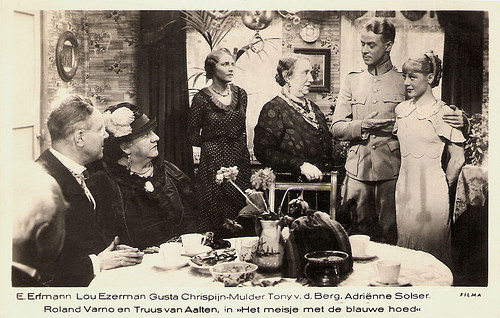
Dutch postcard by M. B. & Z. (M. Bonnist & Zonen, Amsterdam). Photo: Filma. Publicity still for Het Meisje met de Blauwe Hoed/The girl with the blue hat (Rudolf Meinert, 1934) with Eberhard Erfmann, Lau Ezerman , Gusta Chrispijn-Mulder, Tony van den Berg, Adrienne Solser, Roland Varno and Truus van Aalten .
Too wild for him
The film is also described as an army comedy. The story was based on a semi-autobiographical novel which Johan Fabricius published in 1927 and follows the story quite well. Roland Varno plays nerdy Daantje Pieters, who works in a grocery shop in Gouda when he is suddenly called to The Hague to serve for the Dutch army.
In the army, Daantje is the victim of teasing of his fellow soldiers. Especially his roommate Toontje ( Lou Bandy ) has great pleasure in keeping him fooled. The only thing that keeps Daantje going is the thought of 'the girl with the blue hat' ( Truus van Aalten ), a beautiful girl he spotted aboard the train to the garrison.
Despite the unfriendly beginning, smart and sneaky conman Toontje takes Daantje under his wing (not to mention his grocery supplies). During a visit to a revue of Lou Bandy Daantje notices again the girl with the blue hat. He is too shy to approach her, but Toontje arranges a meeting in a bar, to the chagrin of her date. The girl, who answers to the name Betsy, is attracted to Daantje and the two spend a romantic evening.
Daantjes mother (Adriënne Solser) is not impressed by the sexually liberated Betsy and sees her son would rather marry his neighbour Hilda Jansma (Tony van den Berg). Back in The Hague Betsy realizes that she and Danny do not fit together. She explains that she is too wild for him and breaks off the engagement.
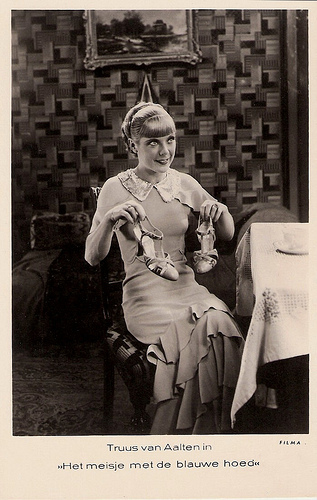
Dutch postcard by M. B.& Z. (M. Bonnist & Zonen, Amsterdam). Photo: Filma. Publicity still for Het Meisje met de Blauwe Hoed/The girl with the blue hat (Rudolf Meinert, 1934) with Truus van Aalten .
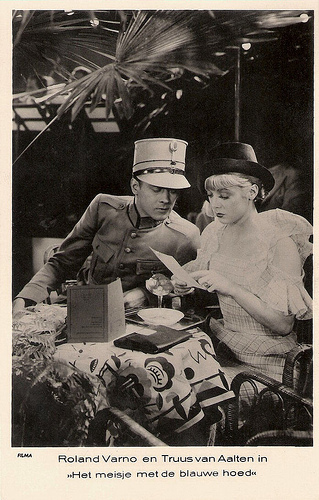
Dutch postcard by M. B.& Z. (M. Bonnist & Zonen, Amsterdam). Photo: Filma. Publicity still for Het Meisje met de Blauwe Hoed/The girl with the blue hat (Rudolf Meinert, 1934) with Roland Varno and Truus van Aalten .
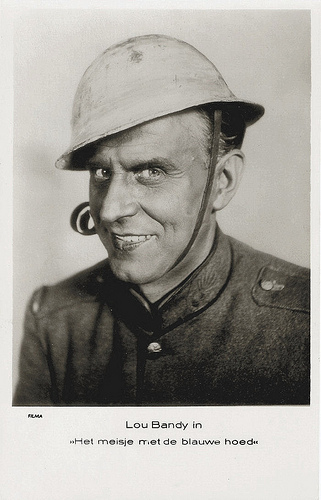
Dutch postcard by M. B. & Z. (M. Bonnist & Zonen, Amsterdam). Photo: Filma. Publicity still for Het Meisje met de Blauwe Hoed/The girl with the blue hat (1934) with Lou Bandy .
War Propaganda
During the Second World War, Het Meisje met de Blauwe Hoed/The girl with the blue hat was banned by the Nazis along with two other Dutch films, De Big van het Regiment/The Regiment's Mascot (Max Nosseck, 1935) and Ergens in Nederland/Somewhere in the Netherlands (Ludwig Berger, 1940) because of 'war propaganda'.
Chip Douglas at IMDb loves the film: "As a piece of Dutch cinema history this film is a clear standout. " About Varno and Van Aalten he notes: "They play their parts well, but it is Bandy who dominates the picture. His contribution, as well as the musical numbers managed to bring in a large enough audience to break even. However, writer Fabricius apparently wasn't very pleased when he found out they turned his book into a musical."
In 1972, a seven-part Dutch television series was broadcast, Het Meisje met de Blauwe Hoed/The girl with the blue hat (Dick van 't Sant, 1972) with Huib Rooymans, Jenny Arean and André van Duin in the lead roles. Rooijmans and Arean were married at the time, but divorced in 1973. Due to its length, the story was reworked and the very popular TV series contained more scenes and even more songs. Fabricius possibly turned in his grave.
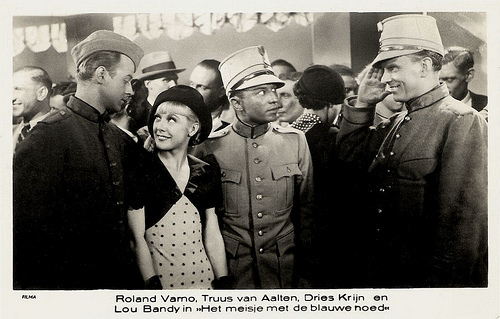
Dutch postcard by M. B.& Z. (M. Bonnist & Zonen, Amsterdam). Photo: Filma. Publicity still for Het Meisje met de Blauwe Hoed (1934) with Roland Varno , Truus van Aalten , Dries Krijn en Lou Bandy .
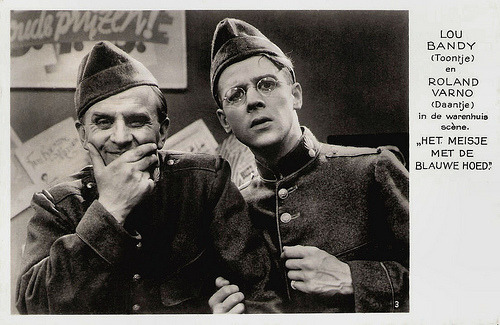
Dutch postcard by R.E.B., no. 3. Photo: publicity still for Het Meisje met de Blauwe Hoed/The girl with the blue hat (1934) with Lou Bandy and Roland Varno .
Scene from Het Meisje met de Blauwe Hoed/The girl with the blue hat (1934). Source: Kanaal van Johanpa3 (YouTube).
Scene from the TV series with André van Duin singing Vaste verkering. Source: Johnny Keurntjes (YouTube).
Sources: Henk van Gelder (Hollands Hollywood - Dutch), Kathinka Dittrich (Geschiedenis van de Nederlandse Film en Bioscoop tot 1940 - Dutch), Chip Douglas (IMDb), Wikipedia (Dutch) and IMDb.

Dutch postcard by M. B.& Z. (M. Bonnist & Zonen, Amsterdam). Photo: Filma.Publicity still for Het Meisje met de Blauwe Hoed/The girl with the blue hat (Rudolf Meinert, 1934) with Tony van den Berg and Roland Varno .

Dutch postcard by M. B.& Z. (M. Bonnist & Zonen, Amsterdam). Photo: Filma. Publicity still for Het meisje met den blauwen hoed/ The Girl with the Blue Hat (Rudolf Meinert, 1934) with Truus van Aalten . Collection: Egbert Barten. Comment by Ali Gardener at Flickr : "It looks like taken very spontaneous and still so perfectly posed! I like also the shadow of the shoes and all those splendid details."

Dutch postcard by M. B.& Z. (M. Bonnist & Zonen, Amsterdam). Photo: Filma. Publicity still for Het meisje met de blauwe hoed/The Girl With the Blue Hat (Rudolf Meinert, 1934) with Roland Varno . Collectie: Egbert Barten.
Unusual for the Netherlands
Het meisje met de blauwe hoed/The girl with the blue hat was an unusual production for the Netherlands in the 1930s. It was the first production by Filma, the film production company of 27 years old Wil Tuschinski, son of cinema chain owner Abraham Tuschinski. For the first time, a moving camera was used in the Cinetone Sound Film studios in Amsterdam. The production costs amounted to 100,000 guilders - a record for the Dutch film industry at the time.
The three stars were also interesting. Dutch-born actor Roland Varno (1908-1996) is best known for his role as one of the schoolboys in Josef von Sternberg's Der blaue Engel/The blue angel (1930). He appeared in several German and Dutch films of the early 1930s and then moved to Hollywood, where he made a film with Greta Garbo , As You Desire me (George Fitzmaurice, 1932). However, he mostly worked in Hollywood as a character actor, often in B-pictures.
The female leading role was played by another Dutch film star with a career abroad, Truus van Aalten (1910-1999). She starred in 29 European films during the 1920s and 1930s. She made most of them in Berlin and Vienna, and Het Meisje met de Blauwe Hoed/The girl with the blue hat was the only film she made in the Netherlands.
Singer and entertainer Lou Bandy (1890-1959) played a dual role in Het meisje met de blauwe hoed/The girl with the blue hat as Toontje and as himself. Bandy was one of the most popular artists of The Netherlands between the two world wars. His songs Zoek de zon op (Look for the sun) and Louise zit niet op je nagels te bijten (Louise, don't bite your nails) became Dutch evergreens. In this film, Bandy sings the songs In de petoet (In the brig) and Vaste verkering (Steady dating) which soon became hits in the Netherlands.

Dutch postcard by M. B. & Z. (M. Bonnist & Zonen, Amsterdam). Photo: Filma. Publicity still for Het Meisje met de Blauwe Hoed/The girl with the blue hat (Rudolf Meinert, 1934) with Lou Bandy .

Dutch postcard by M. B. & Z. (M. Bonnist & Zonen, Amsterdam). Photo: Filma. Publicity still for Het Meisje met de Blauwe Hoed/The girl with the blue hat (Rudolf Meinert, 1934) with Lou Bandy .

Dutch postcard by M. B. & Z. (M. Bonnist & Zonen, Amsterdam). Photo: Filma. Publicity still for Het Meisje met de Blauwe Hoed/The girl with the blue hat (Rudolf Meinert, 1934) with Eberhard Erfmann, Lau Ezerman , Gusta Chrispijn-Mulder, Tony van den Berg, Adrienne Solser, Roland Varno and Truus van Aalten .
Too wild for him
The film is also described as an army comedy. The story was based on a semi-autobiographical novel which Johan Fabricius published in 1927 and follows the story quite well. Roland Varno plays nerdy Daantje Pieters, who works in a grocery shop in Gouda when he is suddenly called to The Hague to serve for the Dutch army.
In the army, Daantje is the victim of teasing of his fellow soldiers. Especially his roommate Toontje ( Lou Bandy ) has great pleasure in keeping him fooled. The only thing that keeps Daantje going is the thought of 'the girl with the blue hat' ( Truus van Aalten ), a beautiful girl he spotted aboard the train to the garrison.
Despite the unfriendly beginning, smart and sneaky conman Toontje takes Daantje under his wing (not to mention his grocery supplies). During a visit to a revue of Lou Bandy Daantje notices again the girl with the blue hat. He is too shy to approach her, but Toontje arranges a meeting in a bar, to the chagrin of her date. The girl, who answers to the name Betsy, is attracted to Daantje and the two spend a romantic evening.
Daantjes mother (Adriënne Solser) is not impressed by the sexually liberated Betsy and sees her son would rather marry his neighbour Hilda Jansma (Tony van den Berg). Back in The Hague Betsy realizes that she and Danny do not fit together. She explains that she is too wild for him and breaks off the engagement.

Dutch postcard by M. B.& Z. (M. Bonnist & Zonen, Amsterdam). Photo: Filma. Publicity still for Het Meisje met de Blauwe Hoed/The girl with the blue hat (Rudolf Meinert, 1934) with Truus van Aalten .

Dutch postcard by M. B.& Z. (M. Bonnist & Zonen, Amsterdam). Photo: Filma. Publicity still for Het Meisje met de Blauwe Hoed/The girl with the blue hat (Rudolf Meinert, 1934) with Roland Varno and Truus van Aalten .

Dutch postcard by M. B. & Z. (M. Bonnist & Zonen, Amsterdam). Photo: Filma. Publicity still for Het Meisje met de Blauwe Hoed/The girl with the blue hat (1934) with Lou Bandy .
War Propaganda
During the Second World War, Het Meisje met de Blauwe Hoed/The girl with the blue hat was banned by the Nazis along with two other Dutch films, De Big van het Regiment/The Regiment's Mascot (Max Nosseck, 1935) and Ergens in Nederland/Somewhere in the Netherlands (Ludwig Berger, 1940) because of 'war propaganda'.
Chip Douglas at IMDb loves the film: "As a piece of Dutch cinema history this film is a clear standout. " About Varno and Van Aalten he notes: "They play their parts well, but it is Bandy who dominates the picture. His contribution, as well as the musical numbers managed to bring in a large enough audience to break even. However, writer Fabricius apparently wasn't very pleased when he found out they turned his book into a musical."
In 1972, a seven-part Dutch television series was broadcast, Het Meisje met de Blauwe Hoed/The girl with the blue hat (Dick van 't Sant, 1972) with Huib Rooymans, Jenny Arean and André van Duin in the lead roles. Rooijmans and Arean were married at the time, but divorced in 1973. Due to its length, the story was reworked and the very popular TV series contained more scenes and even more songs. Fabricius possibly turned in his grave.

Dutch postcard by M. B.& Z. (M. Bonnist & Zonen, Amsterdam). Photo: Filma. Publicity still for Het Meisje met de Blauwe Hoed (1934) with Roland Varno , Truus van Aalten , Dries Krijn en Lou Bandy .

Dutch postcard by R.E.B., no. 3. Photo: publicity still for Het Meisje met de Blauwe Hoed/The girl with the blue hat (1934) with Lou Bandy and Roland Varno .
Scene from Het Meisje met de Blauwe Hoed/The girl with the blue hat (1934). Source: Kanaal van Johanpa3 (YouTube).
Scene from the TV series with André van Duin singing Vaste verkering. Source: Johnny Keurntjes (YouTube).
Sources: Henk van Gelder (Hollands Hollywood - Dutch), Kathinka Dittrich (Geschiedenis van de Nederlandse Film en Bioscoop tot 1940 - Dutch), Chip Douglas (IMDb), Wikipedia (Dutch) and IMDb.
Published on May 29, 2015 22:00
May 28, 2015
Michel Simon
Swiss actor Michel Simon (1895-1975) was a popular and beloved star of the French cinema and stage. His larger than life personality, impeccable comic timing and great repertoire were seen in more than 100 films. He started his film career during the silent period, and starred in classic masterpieces by Carl Theodor Dreyer, Jean Vigo, Marcel Carné and Jean Renoir.
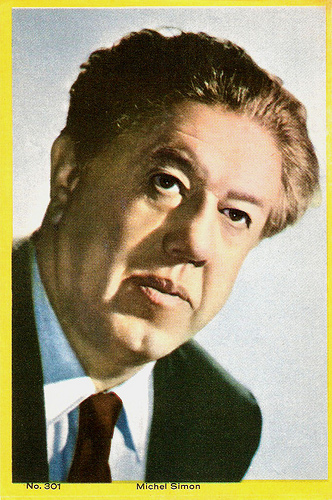
Mexican card, no. 301.
General Insubordination
François Michel Simon was born in Geneva, Switzerland in 1895. He used to say about himself that "as misfortune never comes singly, cinema was born the same year". He was the son of a Protestant sausage maker.
Simon drifted through his early years as a boxer, commercial photographer and acrobat. In 1912 he was magician, clown and acrobat stooge in a dancers' show called Ribert's and Simon's, in the Montreuil-sous-Bois Casino. Conscripted into the Swiss Army in 1914, he was thrown out through a combination of tuberculosis and general insubordination.
In 1915, he saw Georges Pitoëff acting in Hedda Gabler, at the Theatre de la Comédie of Geneva. He then decided to become an actor too, but had to wait until 1920 before making his first brief appearance on stage, with Pitoëff's company, speaking three lines for the registrar role in William Shakespeare's Measure for Measure.
He was spotted for the first time in a supporting role in George Bernard Shaw's Androcles and the Lion. In 1922, his company moved to Paris at the Comédie des Champs-Élysées.
He quit the following year to become a light comedy actor in plays by Tristan Bernard, Marcel Achard and Yves Mirande. Marcel Achard presented him to Charles Dullin , in whose company he acted in Je ne vous aime pas (I Don't Love You) with Valentine Tessier.
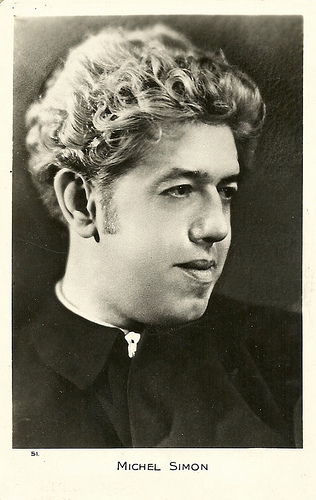
French postcard by Cinémagazine, no. 51.
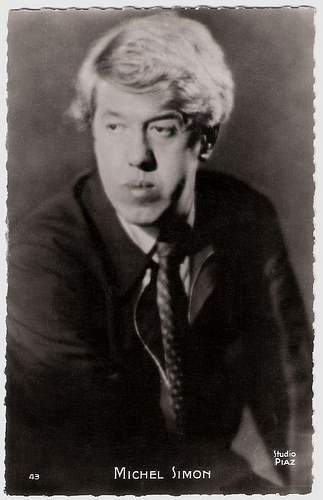
French postcard by Editions P.I., Paris, no. 43. Photo: Studio Piaz.
Unusual Face
Louis Jouvet , who had meanwhile replaced Pitoëff, hired Michel Simon at the Comédie des Champs-Élysées. Simon then gave a brilliant performance in Jean de la Lune, a play by Marcel Achard. His inimitable talent transformed his Cloclo supporting role to the big attraction of the play.
His theatrical career then blossomed with a large repertoire: Shakespeare, George Bernard Shaw, Luigi Pirandello, Oscar Wilde, Henri Bernstein, but it was film that made him most popular.
One of his first film appearances was as Pomino opposite Ivan Mozzhukhin in Feu Mathias Pascal/The Late Mathias Pascal (1925), based on the novel by Luigi Pirandello and directed by Marcel L'Herbier.
Very soon after, he appeared in La vocation d'André Carel/The Vocation of André Carel (Jean Choux, 1925) with Blanche Montel . The film used small-scale production methods, just as the Nouvelle Vague would do from 1958 on.
Essentially a theatre performer throughout the 1920s, Simon occasionally appeared in small film roles, notably in Casanova (Alexandre Volkoff, 1927) and as Jean LeMaitre in La Passion de Jeanne d'Arc/The Passion of Joan of Arc (Carl Theodor Dreyer, 1928).
In these silent films, he brought his amazing appearance and his unusual face - a talent with an exceptional mobility, but truly without mannerism. He easily played with his body using an unlimited virtuosity, especially his ugliness, evolving from smartness to sympathy, goodness to naivety, ludicrousness to frightening, stupidity to comical, mischievousness to cruelty.
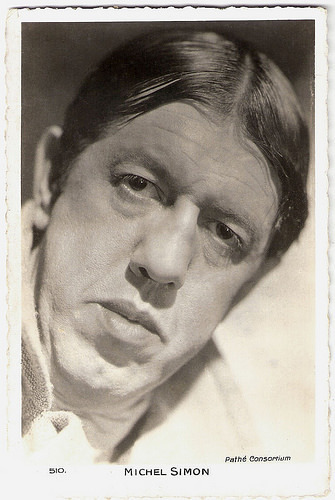
French postcard by Ed. Chantal, Paris, no. 510. Photo: Pathé Consortium.
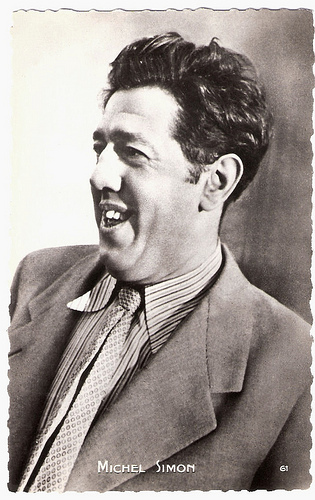
French postcard by Editions P.I., Paris, no. 61. Offered by Les Carbones Korès 'Carboplane'.
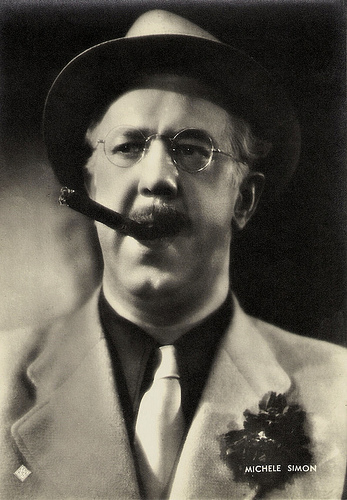
Italian postcard by ASER (A. Scarmiglia Ed. Roma). Photo: Pesce. Publicity still for La comédie du Bonheur/Comedy of Happiness (Marcel L'Herbier, 1940).
Outstanding Character Actor
With the coming of sound film, Michel Simon became firmly established as one of France's outstanding character actors. Full film stardom came his way when, in 1931, Simon starred in the film version of his great stage success Jean De La Lune/Moon-Struck Jean (Jean Choux, 1931) with Madeleine Renaud . People remarked that his elocution and voice tone were as original as his appearance and play.
As Hal Erickson at AllMovie writes: “His screen performances of the 1930s remain fresh and alive even after six decades, largely due to Simon's sudden spurts of improvisation”. Especially his roles in the films directed by Jean Renoir, such as the bitter and highly controversial psychological drama La Chienne/The Bitch (1931), the comedy On Purge Bebé/We Purge Baby (1932) and Boudu Sauvé Des Eaux/Boudu Saved From Drowning (1932). The latter was remade in Hollywood as Down and Out in Beverly Hills (1986, Paul Mazursky) with Nick Nolte in the Michel Simon role, Richard Dreyfuss and Bette Midler.
Hal Erickson continues: “Renoir has credited the actor with introducing the ‘improv’ technique to French filmmaking. Capable of harnessing his rocky-road face, bulky body and shambling manner for the purposes of menace as well as mirth, Simon proved a fearsome creature in Jean Vigo's last film, L'Atlante (1934) opposite lovely Dita Parlo .”
It is probably for his role as Père Jules in L’Atalante that he will be best known: the slightly roguish, ageing barge-man with a heart of gold. He went on to work with another great director, Marcel Carné, on the comedy-farce Drôle de Drame/Bizarre, Bizarre (Marcel Carné, 1937) with Louis Jouvet , and the romantic drama Le Quai des Brumes/Port of Shadows (Marcel Carné, 1938) with Jean Gabin .
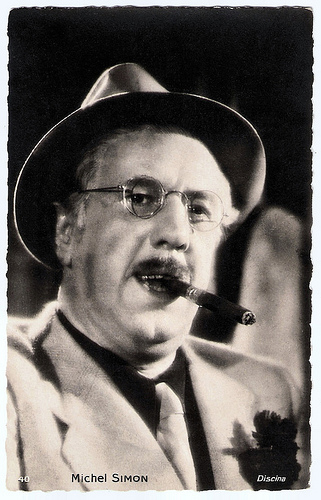
French postcard by Ed. Chantal, Rueil, no. 40. Photo: Discina. Publicity still for La comédie du Bonheur/Comedy of Happiness (Marcel L'Herbier, 1940).
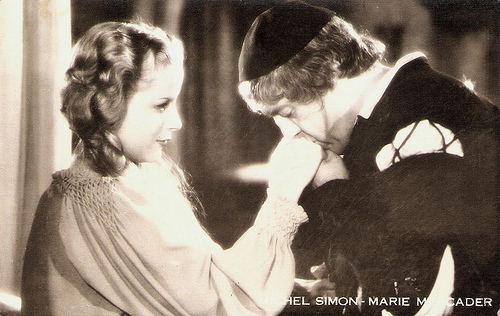
Italian postcard. Photo: publicity still of Maria Mercader and Michel Simon in Il re si diverte/The King's Jester (Mario Bonnard, 1941).
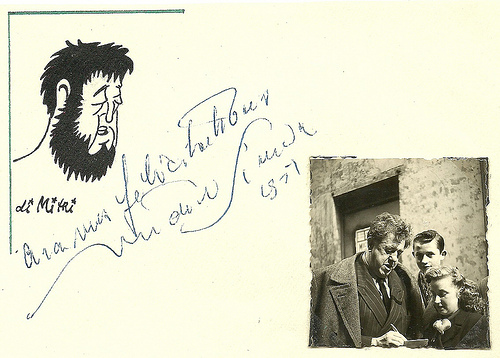
Photo with dedication. Collection: Didier Hanson.
Faust and Mephistopheles
Michel Simon later also worked with such other A-list directors as Julien Duvivier at La Fin du Jour/The End of the Day (1939) and Panique/Panic (1946), and René Clair, appearing in the latter's La Beauté du Diable/Beauty and the Devil (1950) opposite Gérard Philipe as both Faust and Mephistopheles.
In 1957, Simon's film career nearly came to an abrupt end when he suffered facial and body paralysis as a by-product of an impure makeup dye. Despite his reduced physical mobility, he painstakingly made a comeback.
Hal Erickson: “Having been forced into minor parts for several years by a debilitating illness, veteran film actor Michel Simon made a triumphant return to leading roles in the charming, poignant Le Vieil Homme et L'Enfant/The Two of Us (Claude Berri, 1967).” That year, he won the Silver Bear for Best Actor at the 17th Berlin International Film Festival for his penetrating portrayal of an anti-Semitic French peasant in this beautiful film.
After that he made a few more films, including Walerian Borowczyk's Blanche (1971), a tragic romantic tale set in 13th century France, and his final film the crime drama L'Ibis Rouge/The Red Ibis (Jean-Pierre Mocky, 1975).
All reports indicate that Michel Simon conducted his private life in the manner of one of his gross, eccentric film characters: he lived alone on a huge country estate, sharing space with a pet parrot and four apes.
Michel Simon died in 1975 in Bry-sur-Marne, France, from a pulmonary embolism. His latest companion was the German artist Margarethe Krieger. The actor François Simon (1917) is his son.
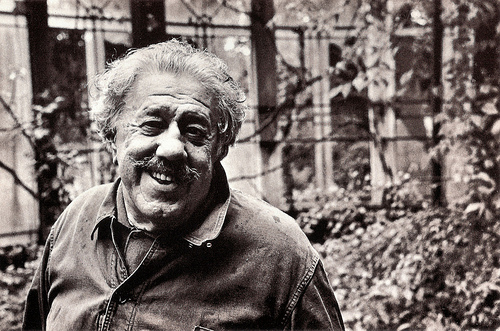
French postcard by OPSIS, Paris, no. C 7 - Personalités du XXe siècle. Photo: J. Mounicq.
Scene from Drôle de Drame/Bizarre, Bizarre (1937) with Louis Jouvet . Source: Julien Morvan (YouTube).
Commercial for cigarettes. Source: ROBAGGIO10 (YouTube).
Scene from Le Vieil Homme et L'Enfant/The Two of Us (1967). Source: Bethoetpopeck (YouTube).
Sources: Hal Erickson (AllMovie), (IMDb), Les Amis de Michel Simon (French), Wikipedia and .

Mexican card, no. 301.
General Insubordination
François Michel Simon was born in Geneva, Switzerland in 1895. He used to say about himself that "as misfortune never comes singly, cinema was born the same year". He was the son of a Protestant sausage maker.
Simon drifted through his early years as a boxer, commercial photographer and acrobat. In 1912 he was magician, clown and acrobat stooge in a dancers' show called Ribert's and Simon's, in the Montreuil-sous-Bois Casino. Conscripted into the Swiss Army in 1914, he was thrown out through a combination of tuberculosis and general insubordination.
In 1915, he saw Georges Pitoëff acting in Hedda Gabler, at the Theatre de la Comédie of Geneva. He then decided to become an actor too, but had to wait until 1920 before making his first brief appearance on stage, with Pitoëff's company, speaking three lines for the registrar role in William Shakespeare's Measure for Measure.
He was spotted for the first time in a supporting role in George Bernard Shaw's Androcles and the Lion. In 1922, his company moved to Paris at the Comédie des Champs-Élysées.
He quit the following year to become a light comedy actor in plays by Tristan Bernard, Marcel Achard and Yves Mirande. Marcel Achard presented him to Charles Dullin , in whose company he acted in Je ne vous aime pas (I Don't Love You) with Valentine Tessier.

French postcard by Cinémagazine, no. 51.

French postcard by Editions P.I., Paris, no. 43. Photo: Studio Piaz.
Unusual Face
Louis Jouvet , who had meanwhile replaced Pitoëff, hired Michel Simon at the Comédie des Champs-Élysées. Simon then gave a brilliant performance in Jean de la Lune, a play by Marcel Achard. His inimitable talent transformed his Cloclo supporting role to the big attraction of the play.
His theatrical career then blossomed with a large repertoire: Shakespeare, George Bernard Shaw, Luigi Pirandello, Oscar Wilde, Henri Bernstein, but it was film that made him most popular.
One of his first film appearances was as Pomino opposite Ivan Mozzhukhin in Feu Mathias Pascal/The Late Mathias Pascal (1925), based on the novel by Luigi Pirandello and directed by Marcel L'Herbier.
Very soon after, he appeared in La vocation d'André Carel/The Vocation of André Carel (Jean Choux, 1925) with Blanche Montel . The film used small-scale production methods, just as the Nouvelle Vague would do from 1958 on.
Essentially a theatre performer throughout the 1920s, Simon occasionally appeared in small film roles, notably in Casanova (Alexandre Volkoff, 1927) and as Jean LeMaitre in La Passion de Jeanne d'Arc/The Passion of Joan of Arc (Carl Theodor Dreyer, 1928).
In these silent films, he brought his amazing appearance and his unusual face - a talent with an exceptional mobility, but truly without mannerism. He easily played with his body using an unlimited virtuosity, especially his ugliness, evolving from smartness to sympathy, goodness to naivety, ludicrousness to frightening, stupidity to comical, mischievousness to cruelty.

French postcard by Ed. Chantal, Paris, no. 510. Photo: Pathé Consortium.

French postcard by Editions P.I., Paris, no. 61. Offered by Les Carbones Korès 'Carboplane'.

Italian postcard by ASER (A. Scarmiglia Ed. Roma). Photo: Pesce. Publicity still for La comédie du Bonheur/Comedy of Happiness (Marcel L'Herbier, 1940).
Outstanding Character Actor
With the coming of sound film, Michel Simon became firmly established as one of France's outstanding character actors. Full film stardom came his way when, in 1931, Simon starred in the film version of his great stage success Jean De La Lune/Moon-Struck Jean (Jean Choux, 1931) with Madeleine Renaud . People remarked that his elocution and voice tone were as original as his appearance and play.
As Hal Erickson at AllMovie writes: “His screen performances of the 1930s remain fresh and alive even after six decades, largely due to Simon's sudden spurts of improvisation”. Especially his roles in the films directed by Jean Renoir, such as the bitter and highly controversial psychological drama La Chienne/The Bitch (1931), the comedy On Purge Bebé/We Purge Baby (1932) and Boudu Sauvé Des Eaux/Boudu Saved From Drowning (1932). The latter was remade in Hollywood as Down and Out in Beverly Hills (1986, Paul Mazursky) with Nick Nolte in the Michel Simon role, Richard Dreyfuss and Bette Midler.
Hal Erickson continues: “Renoir has credited the actor with introducing the ‘improv’ technique to French filmmaking. Capable of harnessing his rocky-road face, bulky body and shambling manner for the purposes of menace as well as mirth, Simon proved a fearsome creature in Jean Vigo's last film, L'Atlante (1934) opposite lovely Dita Parlo .”
It is probably for his role as Père Jules in L’Atalante that he will be best known: the slightly roguish, ageing barge-man with a heart of gold. He went on to work with another great director, Marcel Carné, on the comedy-farce Drôle de Drame/Bizarre, Bizarre (Marcel Carné, 1937) with Louis Jouvet , and the romantic drama Le Quai des Brumes/Port of Shadows (Marcel Carné, 1938) with Jean Gabin .

French postcard by Ed. Chantal, Rueil, no. 40. Photo: Discina. Publicity still for La comédie du Bonheur/Comedy of Happiness (Marcel L'Herbier, 1940).

Italian postcard. Photo: publicity still of Maria Mercader and Michel Simon in Il re si diverte/The King's Jester (Mario Bonnard, 1941).

Photo with dedication. Collection: Didier Hanson.
Faust and Mephistopheles
Michel Simon later also worked with such other A-list directors as Julien Duvivier at La Fin du Jour/The End of the Day (1939) and Panique/Panic (1946), and René Clair, appearing in the latter's La Beauté du Diable/Beauty and the Devil (1950) opposite Gérard Philipe as both Faust and Mephistopheles.
In 1957, Simon's film career nearly came to an abrupt end when he suffered facial and body paralysis as a by-product of an impure makeup dye. Despite his reduced physical mobility, he painstakingly made a comeback.
Hal Erickson: “Having been forced into minor parts for several years by a debilitating illness, veteran film actor Michel Simon made a triumphant return to leading roles in the charming, poignant Le Vieil Homme et L'Enfant/The Two of Us (Claude Berri, 1967).” That year, he won the Silver Bear for Best Actor at the 17th Berlin International Film Festival for his penetrating portrayal of an anti-Semitic French peasant in this beautiful film.
After that he made a few more films, including Walerian Borowczyk's Blanche (1971), a tragic romantic tale set in 13th century France, and his final film the crime drama L'Ibis Rouge/The Red Ibis (Jean-Pierre Mocky, 1975).
All reports indicate that Michel Simon conducted his private life in the manner of one of his gross, eccentric film characters: he lived alone on a huge country estate, sharing space with a pet parrot and four apes.
Michel Simon died in 1975 in Bry-sur-Marne, France, from a pulmonary embolism. His latest companion was the German artist Margarethe Krieger. The actor François Simon (1917) is his son.

French postcard by OPSIS, Paris, no. C 7 - Personalités du XXe siècle. Photo: J. Mounicq.
Scene from Drôle de Drame/Bizarre, Bizarre (1937) with Louis Jouvet . Source: Julien Morvan (YouTube).
Commercial for cigarettes. Source: ROBAGGIO10 (YouTube).
Scene from Le Vieil Homme et L'Enfant/The Two of Us (1967). Source: Bethoetpopeck (YouTube).
Sources: Hal Erickson (AllMovie), (IMDb), Les Amis de Michel Simon (French), Wikipedia and .
Published on May 28, 2015 22:00
May 27, 2015
Harry Cort
Polish actor Harry Cort (1905-?) came from a royal dynasty and had a short film career with starring roles in three silent films, 9:25. Przygoda jednej nocy (1929), Halka (1930) and Karuzela zycia (1930). A 'social scandal' ended the career of the handsome actor.
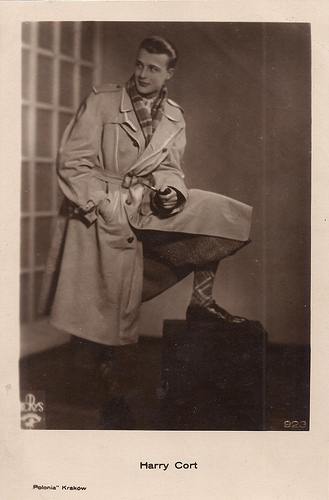
Polish postcard by Polonia, Krakow, no. 923. Collection: Joanna.
Dressed as a Girl
Harry Cort was born Prince Stanisław Józef Gedyminowicz-Bielski in Trzeszczany near Zamosc, Russia (now Poland). Staś Bielski was born in the lineage of the Gediminids dynasty of monarchs in the Grand Duchy of Lithuania, that reigned from the 14th to the 16th century.
At the age of seven years, he and his family went abroad and toured southern Europe, Africa and Asia. In Austria, he witnessed the outbreak of World War I, and in 1919, he survived the Budapest Hungarian communist revolution.
In 1924 he returned to Poland and joined the Corps of Cadets Lviv. He graduated high school in Warsaw and then went to study in Paris.
At the end of the 1920s he returned to Poland. The Polish site Queer relates how the very handsome 21-years old Staś Bielski once visited a ball dressed as a girl. The result turned out to be impressive: "He looked phenomenal, moving up beautifully, it took only fakes for what he was lacking in the figure, his neck was covered with a scarf and his low voice was explained by a cold."
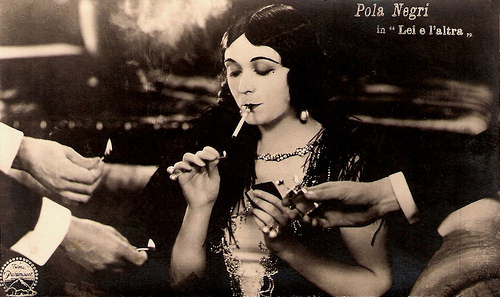
Italian postcard by Ed. Ballerini & Fratini, Firenze. Photo: publicity still of Pola Negri in Good and Naughty (Malcolm St. Clair, 1926).
Social Scandal
Staś Bielski met author and film critic Maria Jehanne Wielopolska who persuaded him to try to play for the cinema.
His film debut was the adventure film 9:25. Przygoda jednej nocy/9:25. Adventure one night (Adam Augustynowicz, Ryszard Biske, 1929) in which he co-starred with Iza Norska. The film is now considered lost.
The following year he played the male lead in the drama Halka (Konstanty Meglicki, 1930). Halka was played by Zorika Szymanska. The film was a remake of the early Polish film Halka (1913), based on an opera by Wlodzimierz Wolski. Later followed a sound version, Halka (Juliusz Gardan, 1937) starring Liliana Zielinska as Halka.
Harry Cort’s third and final film was the romantic comedy Karuzela zycia/Carousel of life (Boleslaw Micinski, 1930) in which he co-starred again with Iza Norska. This film is also considered as lost.
With the advent of the sound films Harry Cort began an intensive study to learn singing and diction. In the early days of the sound era, films were recorded in various languages. Harry Cort prepared to play in films spoken in Polish, German and French. With his knowledge of languages and contacts with Polish Hollywood star Pola Negri , he wanted to play in foreign films.
By the late 1930s he was involved in a ‘social scandal’ that shattered his plans for acting, according to the Polish website Nitrofilm . I could not find more details about this scandal. Probably he then went abroad.
The further fate of Harry Cort or Prince Gedyminowicz-Bielski is unknown.
Sources: Queer (Polish), Nitrofilm (Polish), Film Polski (Polish), Filmweb (Polish) and .

Polish postcard by Polonia, Krakow, no. 923. Collection: Joanna.
Dressed as a Girl
Harry Cort was born Prince Stanisław Józef Gedyminowicz-Bielski in Trzeszczany near Zamosc, Russia (now Poland). Staś Bielski was born in the lineage of the Gediminids dynasty of monarchs in the Grand Duchy of Lithuania, that reigned from the 14th to the 16th century.
At the age of seven years, he and his family went abroad and toured southern Europe, Africa and Asia. In Austria, he witnessed the outbreak of World War I, and in 1919, he survived the Budapest Hungarian communist revolution.
In 1924 he returned to Poland and joined the Corps of Cadets Lviv. He graduated high school in Warsaw and then went to study in Paris.
At the end of the 1920s he returned to Poland. The Polish site Queer relates how the very handsome 21-years old Staś Bielski once visited a ball dressed as a girl. The result turned out to be impressive: "He looked phenomenal, moving up beautifully, it took only fakes for what he was lacking in the figure, his neck was covered with a scarf and his low voice was explained by a cold."

Italian postcard by Ed. Ballerini & Fratini, Firenze. Photo: publicity still of Pola Negri in Good and Naughty (Malcolm St. Clair, 1926).
Social Scandal
Staś Bielski met author and film critic Maria Jehanne Wielopolska who persuaded him to try to play for the cinema.
His film debut was the adventure film 9:25. Przygoda jednej nocy/9:25. Adventure one night (Adam Augustynowicz, Ryszard Biske, 1929) in which he co-starred with Iza Norska. The film is now considered lost.
The following year he played the male lead in the drama Halka (Konstanty Meglicki, 1930). Halka was played by Zorika Szymanska. The film was a remake of the early Polish film Halka (1913), based on an opera by Wlodzimierz Wolski. Later followed a sound version, Halka (Juliusz Gardan, 1937) starring Liliana Zielinska as Halka.
Harry Cort’s third and final film was the romantic comedy Karuzela zycia/Carousel of life (Boleslaw Micinski, 1930) in which he co-starred again with Iza Norska. This film is also considered as lost.
With the advent of the sound films Harry Cort began an intensive study to learn singing and diction. In the early days of the sound era, films were recorded in various languages. Harry Cort prepared to play in films spoken in Polish, German and French. With his knowledge of languages and contacts with Polish Hollywood star Pola Negri , he wanted to play in foreign films.
By the late 1930s he was involved in a ‘social scandal’ that shattered his plans for acting, according to the Polish website Nitrofilm . I could not find more details about this scandal. Probably he then went abroad.
The further fate of Harry Cort or Prince Gedyminowicz-Bielski is unknown.
Sources: Queer (Polish), Nitrofilm (Polish), Film Polski (Polish), Filmweb (Polish) and .
Published on May 27, 2015 22:00
May 26, 2015
Imported from the USA: Raquel Welch
In the following months we will continue our series 'Imported from the USA'. Posts about Hollywood stars who worked intensively in the European cinema. Many did that at the end of their careers. Others became stars in European productions and later returned to the US. We start with one of the icons of the 1960s and 1970s, Raquel Welch (1940). She first won attention for her role in Fantastic Voyage (1966). Then she made in Great Britain One Million Years B.C. (1966). Although she had only three lines in the film, a poster of Welch in a furry prehistoric bikini became an amazing bestseller and catapulted her to stardom.
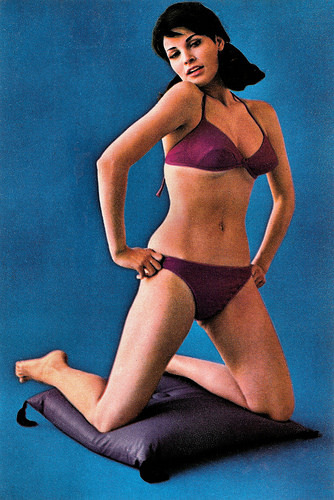
German postcard, no. 100 / 125.
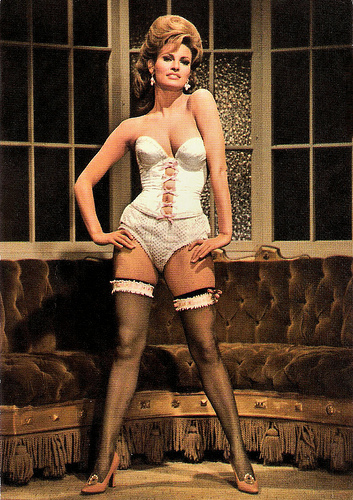
Vintage postcard. Photo: publicity still for Le plus vieux métier du monde/The oldest profession (Michael Pfleghar, 1967).
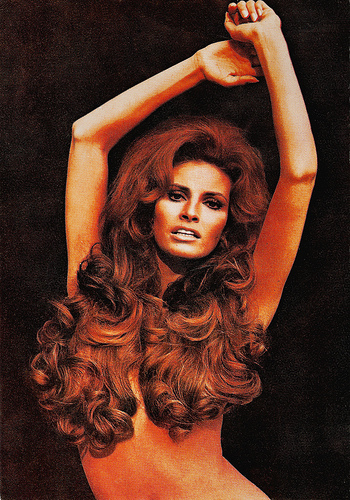
Spanish postcard, no. 11.
Miss Photogenic
Raquel Welch was born Jo Raquel Tejada in 1940 in Chicago, Illinois. She was the first of three children born to Bolivian Armando Carlos Tejada Urquizo, an aerospace engineer, and his Irish-American wife Josephine Sarah Hall, who was the daughter of American architect Emery Stanford Hall.
At age 14, Raquel won her first beauty title beauty title as Miss Photogenic. She graduated from high school in 1958 and a year later, after becoming pregnant, she married her high school sweetheart, James Welch. Seeking an acting career, Welch won a scholarship in drama, took classes at San Diego State College and won several parts in local theatre productions. She got a job as a weather forecaster at KFMB, a local San Diego television station.
After her separation from James Welch, she moved with her two children to Dallas, Texas, where she worked as a model for Neiman Marcus and as a cocktail waitress. In 1963, she went to California, where she met former child star and Hollywood agent Patrick Curtis who became her personal and business manager and second husband. They developed a plan to turn Welch into a sex symbol.
After small roles in a few films and TV series, she had her first featured role in the beach film A Swingin' Summer (Robert Sparr, 1965). She landed a seven-year nonexclusive contract at 20th Century Fox and was cast in a leading role in the sci-fi film Fantastic Voyage (Richard Fleischer, 1966) opposite Stephen Boyd. Welch portrayed a member of a medical team that is miniaturized and injected into the body of an injured diplomat with the mission to save his life. The film was a hit and made her a well-known name.
Fox Studio loaned her to Hammer Studios in Britain where she starred in One Million Years B.C. (Don Chaffey, 1966). Her only costume was a two-piece deer skin bikini. Gary Brumburgh at IMDb : "Tantalizingly wet with her garb clinging to all the right amazonian places, One Million Years B.C. (1966), if nothing else, captured the hearts and libidos of modern men (not to mention their teenage sons) while producing THE most definitive and best-selling pin-up poster of that time."
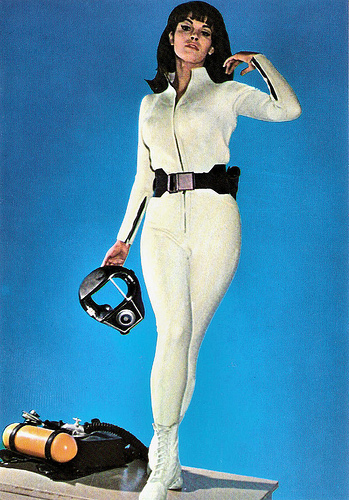
British postcard by Klasik Kards, no. 1541. Photo: publicity still for Fantastic Voyage (Richard Fleischer, 1966).
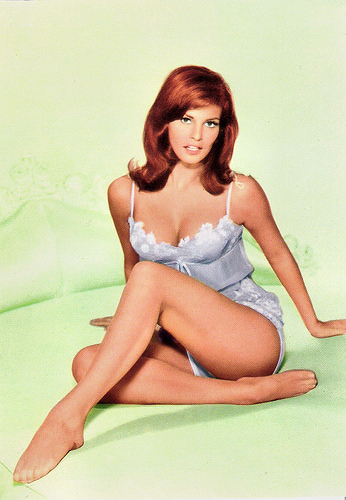
Italian postcard, no. 100/116.
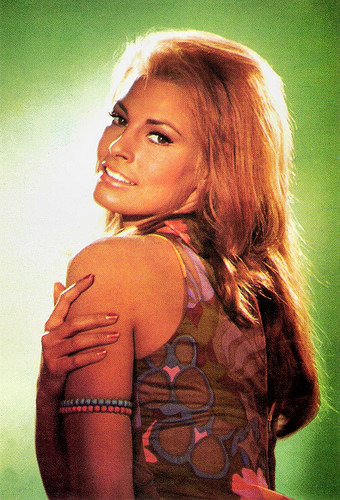
Spanish postcard, no. 597.
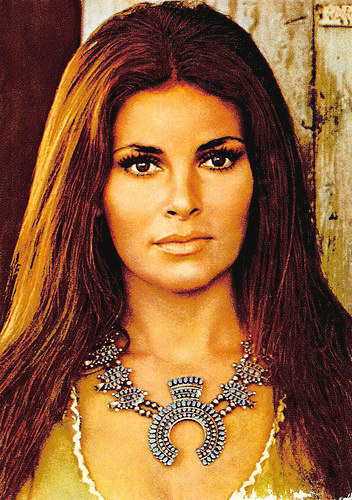
Romanian postcard by Casa Filmului Acin.
Ground-breaking sex scenes
Raquel Welch stayed in Europe for the French comedy Le Plus Vieux Métier du monde/The Oldest Profession (Michael Pfleghar a.o., 1967), a typical European anthology film of the 1960s. A collection of sketches on prostitution through the ages, made by a pan-European cast and crew. Some of the most sensual stars of the era played the leads: Michèle Mercier , Elsa Martinelli , Anna Karina , Nadia Gray , Jeanne Moreau and Welch.
She played Nini in the episode La belle époque/The Gay Nineties by German director Michael Pfleghar. When Nini discovers by accident that her antiquated customer ( Martin Held ) is a banker, she pretends to be an honest woman who has fallen in love with him. She even pays him, just like a gigolo!
Varlaam at IMDb : "Raquel Welch stars in the most amusing episode, relatively speaking. It's apparently set in 1890s Vienna (Emperor Franz Josef is on the paper money). One could probably say that Raquel's greatest classic role was as the injured party in the Cannery Row lawsuit. Finely nuanced she was not, normally. But she makes an appealing light comedienne here, and she can really fill a lacy Viennese corset. The Belle Époque it assuredly was."
Next, she appeared in the British seven-deadly-sins comedy Bedazzled (Stanley Donen, 1967). She played the deadly sin representing 'lust' for the comedy team of Peter Cook and Dudley Moore. In Britain, she was also the title secret agent in the sexy spy spoof Fathom (Leslie H. Martinson, 1967).
In Italy, she starred with Monica Vitti and Claudia Cardinale in Le Fate/The Queens (Mauro Bolognini, 1966) and with Edward G. Robinson and Vittorio de Sica in The Biggest Bundle of Them All (Ken Annakin, 1968).
Back in the United States she appeared in the Western Bandolero! (Andrew V. McLaglen, 1968) with James Stewart and Dean Martin, which was followed by the private-eye drama Lady in Cement (Gordon Douglas, 1968) with Frank Sinatra. She caused quite a stir in her ground-breaking sex scenes with black athlete Jim Brown in the Western 100 Rifles (Tom Gries, 1969).
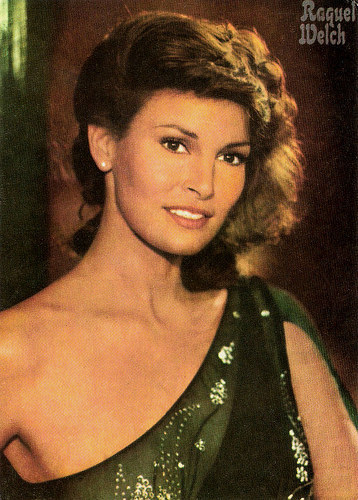
Romanian postcard by Casa Filmului Acin, no. 43079.
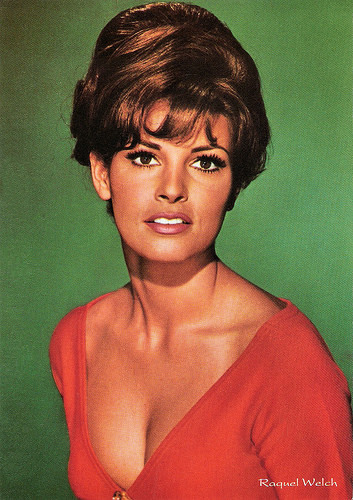
Italian postcard in the Artisti di Sempre series by Rotalfoto, Milano, no. 347.
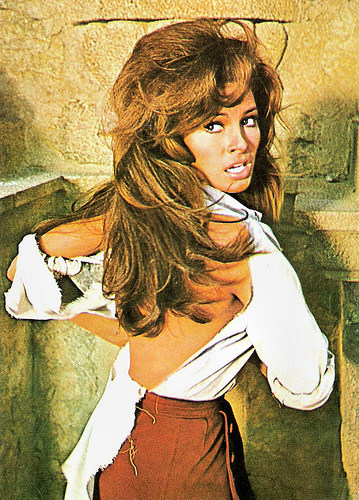
Romanian postcard by Casa Filmului Acin. Photo: publicity still for Bandolero! (Andrew V. McLaglen, 1968).
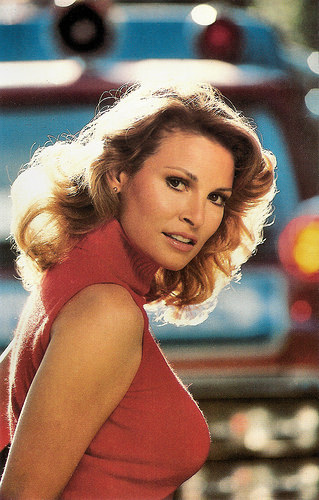
American postcard by Coral-Lee, Rancho Cordova, Ca., no. Personality 21. Photo: Douglas Kirkland, 1978.
Breaking the mould of the submissive sex symbol
Raquel Welch's most controversial role came in the comedy Myra Breckinridge (Michael Sarne, 1970), based on Gore Vidal's 1968 novel. She took the part as the film's transsexual heroine in an attempt to be taken seriously as an actress. The picture was controversial for its sexual explicitness, but unlike the novel, Myra Breckinridge received little to no critical praise. It is cited in the book The Fifty Worst Films of All Time.
Jason Ankeny at AllMovie : "Her situation was unusual; she was certainly a star and a household name, yet few people ever went to see her movies." Welch took a measure of control over her screen persona, producing and starring in Hannie Calder (Burt Kennedy, 1971), the first film in which she carved out a place in movie history portraying strong female characters and breaking the mould of the submissive sex symbol. She altered the image further with Kansas City Bomber (Jerrold Freedman, 1972), insisting on doing her own stunts as good-hearted roller derby star Diane 'KC' Carr.
She followed that with a series of successful films in Europe that included the thriller Bluebeard (Edward Dmytryk, 1972) starring Richard Burton , the swashbuckler The Three Musketeers (Richard Lester, 1973) - for which she won a Golden Globe, the sequel The Four Musketeers (Richard Lester, 1974) both with Oliver Reed and Michael York, and The Wild Party (James Ivory, 1975).
A big hit in Europe was the French action-comedy L'Animal/Animal (Claude Zidi, 1977) starring Jean-Paul Belmondo . Raquel Welch's unique persona on film made her into one the reigning icons of the 1960s and 1970s. Later, she made several television variety specials. In 1980, Welch planned on making a comeback in an adaptation of John Steinbeck's Cannery Row (David S. Ward, 1982), but was fired by the producers a few days into production. The producers said that at 40 years old she was too old to play the character. She was replaced with Debra Winger. Welch sued and collected a $10.8 million settlement.
She starred on Broadway in Woman of the Year, receiving praise for following Lauren Bacall in the title role. She also starred in Victor/Victoria, having less success. In 1995, Welch was chosen by Empire Magazine as one of the 100 Sexiest Stars in Film History.
Her later films include the hit comedy Legally Blonde (Robert Luketic, 2001), starring Reese Witherspoon, and Forget About It (BJ Davis, 2006) with Burt Reynolds. Welch was married four times and is the mother of Damon Welch (1959) and actress Tahnee Welch (1961).
Trailer One Million Years B.C. (1966). Source: John Kelly (YouTube).
Trailer Fantastic Voyage (1966). Source: beowulfooo (YouTube).
Trailer Myra Breckinridge (1970). Source: Sleaze-O-Rama (YouTube).
Sources: Jason Ankeny (AllMovie), (IMDb), David Carless (IMDb), Bob Taylor (IMDb), Varlaam (IMDb), TCM, Wikipedia and .

German postcard, no. 100 / 125.

Vintage postcard. Photo: publicity still for Le plus vieux métier du monde/The oldest profession (Michael Pfleghar, 1967).

Spanish postcard, no. 11.
Miss Photogenic
Raquel Welch was born Jo Raquel Tejada in 1940 in Chicago, Illinois. She was the first of three children born to Bolivian Armando Carlos Tejada Urquizo, an aerospace engineer, and his Irish-American wife Josephine Sarah Hall, who was the daughter of American architect Emery Stanford Hall.
At age 14, Raquel won her first beauty title beauty title as Miss Photogenic. She graduated from high school in 1958 and a year later, after becoming pregnant, she married her high school sweetheart, James Welch. Seeking an acting career, Welch won a scholarship in drama, took classes at San Diego State College and won several parts in local theatre productions. She got a job as a weather forecaster at KFMB, a local San Diego television station.
After her separation from James Welch, she moved with her two children to Dallas, Texas, where she worked as a model for Neiman Marcus and as a cocktail waitress. In 1963, she went to California, where she met former child star and Hollywood agent Patrick Curtis who became her personal and business manager and second husband. They developed a plan to turn Welch into a sex symbol.
After small roles in a few films and TV series, she had her first featured role in the beach film A Swingin' Summer (Robert Sparr, 1965). She landed a seven-year nonexclusive contract at 20th Century Fox and was cast in a leading role in the sci-fi film Fantastic Voyage (Richard Fleischer, 1966) opposite Stephen Boyd. Welch portrayed a member of a medical team that is miniaturized and injected into the body of an injured diplomat with the mission to save his life. The film was a hit and made her a well-known name.
Fox Studio loaned her to Hammer Studios in Britain where she starred in One Million Years B.C. (Don Chaffey, 1966). Her only costume was a two-piece deer skin bikini. Gary Brumburgh at IMDb : "Tantalizingly wet with her garb clinging to all the right amazonian places, One Million Years B.C. (1966), if nothing else, captured the hearts and libidos of modern men (not to mention their teenage sons) while producing THE most definitive and best-selling pin-up poster of that time."

British postcard by Klasik Kards, no. 1541. Photo: publicity still for Fantastic Voyage (Richard Fleischer, 1966).

Italian postcard, no. 100/116.

Spanish postcard, no. 597.

Romanian postcard by Casa Filmului Acin.
Ground-breaking sex scenes
Raquel Welch stayed in Europe for the French comedy Le Plus Vieux Métier du monde/The Oldest Profession (Michael Pfleghar a.o., 1967), a typical European anthology film of the 1960s. A collection of sketches on prostitution through the ages, made by a pan-European cast and crew. Some of the most sensual stars of the era played the leads: Michèle Mercier , Elsa Martinelli , Anna Karina , Nadia Gray , Jeanne Moreau and Welch.
She played Nini in the episode La belle époque/The Gay Nineties by German director Michael Pfleghar. When Nini discovers by accident that her antiquated customer ( Martin Held ) is a banker, she pretends to be an honest woman who has fallen in love with him. She even pays him, just like a gigolo!
Varlaam at IMDb : "Raquel Welch stars in the most amusing episode, relatively speaking. It's apparently set in 1890s Vienna (Emperor Franz Josef is on the paper money). One could probably say that Raquel's greatest classic role was as the injured party in the Cannery Row lawsuit. Finely nuanced she was not, normally. But she makes an appealing light comedienne here, and she can really fill a lacy Viennese corset. The Belle Époque it assuredly was."
Next, she appeared in the British seven-deadly-sins comedy Bedazzled (Stanley Donen, 1967). She played the deadly sin representing 'lust' for the comedy team of Peter Cook and Dudley Moore. In Britain, she was also the title secret agent in the sexy spy spoof Fathom (Leslie H. Martinson, 1967).
In Italy, she starred with Monica Vitti and Claudia Cardinale in Le Fate/The Queens (Mauro Bolognini, 1966) and with Edward G. Robinson and Vittorio de Sica in The Biggest Bundle of Them All (Ken Annakin, 1968).
Back in the United States she appeared in the Western Bandolero! (Andrew V. McLaglen, 1968) with James Stewart and Dean Martin, which was followed by the private-eye drama Lady in Cement (Gordon Douglas, 1968) with Frank Sinatra. She caused quite a stir in her ground-breaking sex scenes with black athlete Jim Brown in the Western 100 Rifles (Tom Gries, 1969).

Romanian postcard by Casa Filmului Acin, no. 43079.

Italian postcard in the Artisti di Sempre series by Rotalfoto, Milano, no. 347.

Romanian postcard by Casa Filmului Acin. Photo: publicity still for Bandolero! (Andrew V. McLaglen, 1968).

American postcard by Coral-Lee, Rancho Cordova, Ca., no. Personality 21. Photo: Douglas Kirkland, 1978.
Breaking the mould of the submissive sex symbol
Raquel Welch's most controversial role came in the comedy Myra Breckinridge (Michael Sarne, 1970), based on Gore Vidal's 1968 novel. She took the part as the film's transsexual heroine in an attempt to be taken seriously as an actress. The picture was controversial for its sexual explicitness, but unlike the novel, Myra Breckinridge received little to no critical praise. It is cited in the book The Fifty Worst Films of All Time.
Jason Ankeny at AllMovie : "Her situation was unusual; she was certainly a star and a household name, yet few people ever went to see her movies." Welch took a measure of control over her screen persona, producing and starring in Hannie Calder (Burt Kennedy, 1971), the first film in which she carved out a place in movie history portraying strong female characters and breaking the mould of the submissive sex symbol. She altered the image further with Kansas City Bomber (Jerrold Freedman, 1972), insisting on doing her own stunts as good-hearted roller derby star Diane 'KC' Carr.
She followed that with a series of successful films in Europe that included the thriller Bluebeard (Edward Dmytryk, 1972) starring Richard Burton , the swashbuckler The Three Musketeers (Richard Lester, 1973) - for which she won a Golden Globe, the sequel The Four Musketeers (Richard Lester, 1974) both with Oliver Reed and Michael York, and The Wild Party (James Ivory, 1975).
A big hit in Europe was the French action-comedy L'Animal/Animal (Claude Zidi, 1977) starring Jean-Paul Belmondo . Raquel Welch's unique persona on film made her into one the reigning icons of the 1960s and 1970s. Later, she made several television variety specials. In 1980, Welch planned on making a comeback in an adaptation of John Steinbeck's Cannery Row (David S. Ward, 1982), but was fired by the producers a few days into production. The producers said that at 40 years old she was too old to play the character. She was replaced with Debra Winger. Welch sued and collected a $10.8 million settlement.
She starred on Broadway in Woman of the Year, receiving praise for following Lauren Bacall in the title role. She also starred in Victor/Victoria, having less success. In 1995, Welch was chosen by Empire Magazine as one of the 100 Sexiest Stars in Film History.
Her later films include the hit comedy Legally Blonde (Robert Luketic, 2001), starring Reese Witherspoon, and Forget About It (BJ Davis, 2006) with Burt Reynolds. Welch was married four times and is the mother of Damon Welch (1959) and actress Tahnee Welch (1961).
Trailer One Million Years B.C. (1966). Source: John Kelly (YouTube).
Trailer Fantastic Voyage (1966). Source: beowulfooo (YouTube).
Trailer Myra Breckinridge (1970). Source: Sleaze-O-Rama (YouTube).
Sources: Jason Ankeny (AllMovie), (IMDb), David Carless (IMDb), Bob Taylor (IMDb), Varlaam (IMDb), TCM, Wikipedia and .
Published on May 26, 2015 22:00
May 25, 2015
Milly Vitale
Milly Vitale (1933-2006) was an Italian actress, who starred in numerous post-war Italian films. She also appeared in a few Hollywood films but never achieved star status like her contemporaries Sophia Loren and Gina Lollobrigida.
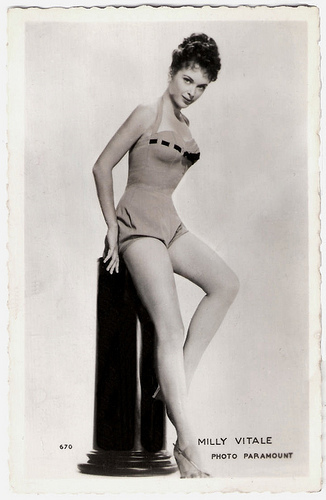
French postcard by Editions P.I., no. 670. Photo: Paramount, 1955.
An innocent girl thrown into a dungeon
Camilla ‘Milly’ Vitale was born in 1933 in Rome, Italy. She was the daughter of conductor Riccardo Vitale, the director of the Rome opera house, and white-Russian choreographer Natasha Shidlowski.
At the age of 15, Milly made her film debut in the Dostoyevsky adaptation I fratelli Karamazoff/The Brothers Karamazoff (Giacomo Gentilomo, 1947), starring Fosco Giachetti . She played her first leading role in the historical melodrama La sepolta viva/Buried Alive (Guido Brignone, 1949) as an innocent girl thrown into a dungeon.
Vitale had her breakthrough in the political drama Anni Dificile/The Difficult Years (Luigi Zampa, 1950). Hal Erickson at AllMovie : “The Difficult Years is another uncompromising neorealist exercise by Italian filmmaker Luigi Zampa. The title refers to the years that Italy spent under the thumb of fascism. It is Zampa's thesis that the majority of Italian citizens preferred to ignore Mussolini's trampling of human rights and his ever-increasing megalomania, so long as they were left in peace.”
Another interesting film is the realistic mafia drama Gli inesorabili/The Fighting Men (Camillo Mastrocinque, Roberto Savarese, 1950), starring Rossano Brazzi . Other films in which she appeared were the war-drama Il Caimano del Piave/The Caiman of the Piave River (Giorgio Bianchi, 1951) with Gino Cervi , the romance-drama Il Tenente Giorgio/Lieutenant Giorgio (Raffaello Matarazzo, 1952) starring Massimo Girotti, and the Swashbuckler A fil di spade/At Sword's Edge (Carlo Ludovico Bragaglia, 1952).
Vitale appeared in a few Hollywood movies like The Juggler (Edward Dmytryk, 1953), a drama about a survivor of the Holocaust, played by Kirk Douglas. In her most notable American role, she co-starred with Bob Hope in The Seven Little Foys (Melville Shavelson, 1956). However she never achieved star status like her contemporaries Sophia Loren and Gina Lollobrigida , and returned to Europe.
In England, she made The Flesh Is Weak (Don Chaffey, 1957) and the war film Battle of the V-1 (Vernon Sewell, 1958), starring Michael Rennie . In Italy, she appeared in the Italian-American coproduction War and Peace (King Vidor, 1957) and the historical epic Annibale/Hannibal (Edgar G. Ulmer, 1959) based on the life of Hannibal (Victor Mature).
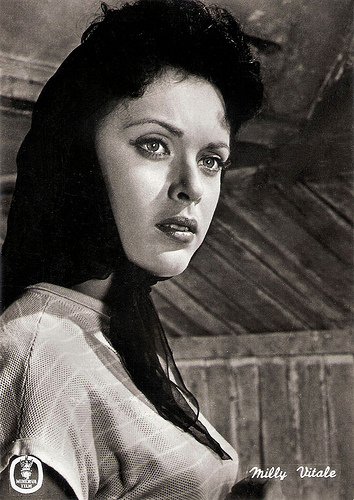
Italian postcard by Bromofoto, Milano, no. 667. Photo: Minerva Film.
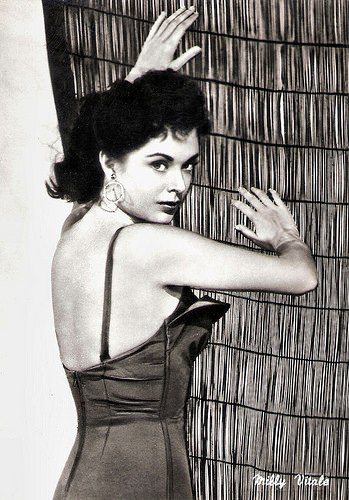
Vintage postcard by Bromofoto, Milano, no. 1199.
The Queen of France
In 1960, Milly Vitale married the American Vincent Hillyer. The marriage produced two sons, Edoardo (1961) and Vincent Jr. (1964). Hillyer’s wife by a previous marriage had been a princess of the Iranian Pahlevi dynasty. Hillyer had converted to Islam, and, as an honorary Iranian citizen, had close ties with the government in Teheran.
In May 1961, Hillyer and Vitale sued the Pan American Petroleum Corporation of Tulsa, Oklahoma, to the tune of $30 million for allegedly reneging on an agreement to pay them an annuity of $25,000 and a 2 1/2 % share in net profits in exchange for Hillyer interceding with the Iranian government on an oil exploration contract. The couple divorced in 1966.
Vitale returned to the screen in the Italian thriller Gangsters '70/Days of Fire (Mino Guerrini, 1968) starring Joseph Cotten. She played small parts in the comedies Il medico della mutual/The Family Doctor (Luigi Zampa, 1968) featuring Alberto Sordi , and Contestazione generale/General dispute (Luigi Zampa, 1970) starring Vittorio Gassman .
Vitale retired from acting in the 1970s. Her final film role was as the Queen of France in the Swashbuckler La grande avventura di Scaramouche/The great adventure of Scaramouche (Piero Pierotti, 1972). The film was originally completed in 1970 but not released until 1972 - after the death of director Piero Pierotti.
Milly Vitale died in 2006 in Rome. She had made nearly 50 films.
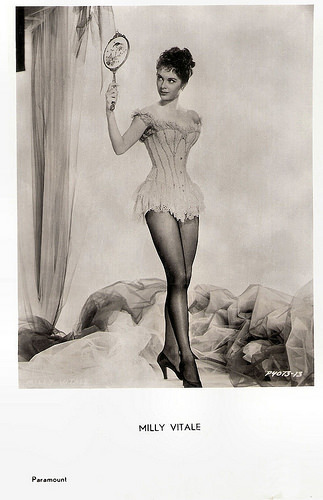
Vintage postcard. Photo: Paramount.
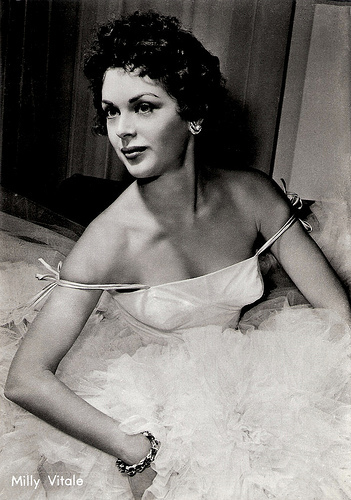
Vintage postcard by Bromostampa, Milano, no. 143.
Sources: Hal Erickson (AllMovie), Glamour Girls of the Silver Screen, Wikipedia, and .

French postcard by Editions P.I., no. 670. Photo: Paramount, 1955.
An innocent girl thrown into a dungeon
Camilla ‘Milly’ Vitale was born in 1933 in Rome, Italy. She was the daughter of conductor Riccardo Vitale, the director of the Rome opera house, and white-Russian choreographer Natasha Shidlowski.
At the age of 15, Milly made her film debut in the Dostoyevsky adaptation I fratelli Karamazoff/The Brothers Karamazoff (Giacomo Gentilomo, 1947), starring Fosco Giachetti . She played her first leading role in the historical melodrama La sepolta viva/Buried Alive (Guido Brignone, 1949) as an innocent girl thrown into a dungeon.
Vitale had her breakthrough in the political drama Anni Dificile/The Difficult Years (Luigi Zampa, 1950). Hal Erickson at AllMovie : “The Difficult Years is another uncompromising neorealist exercise by Italian filmmaker Luigi Zampa. The title refers to the years that Italy spent under the thumb of fascism. It is Zampa's thesis that the majority of Italian citizens preferred to ignore Mussolini's trampling of human rights and his ever-increasing megalomania, so long as they were left in peace.”
Another interesting film is the realistic mafia drama Gli inesorabili/The Fighting Men (Camillo Mastrocinque, Roberto Savarese, 1950), starring Rossano Brazzi . Other films in which she appeared were the war-drama Il Caimano del Piave/The Caiman of the Piave River (Giorgio Bianchi, 1951) with Gino Cervi , the romance-drama Il Tenente Giorgio/Lieutenant Giorgio (Raffaello Matarazzo, 1952) starring Massimo Girotti, and the Swashbuckler A fil di spade/At Sword's Edge (Carlo Ludovico Bragaglia, 1952).
Vitale appeared in a few Hollywood movies like The Juggler (Edward Dmytryk, 1953), a drama about a survivor of the Holocaust, played by Kirk Douglas. In her most notable American role, she co-starred with Bob Hope in The Seven Little Foys (Melville Shavelson, 1956). However she never achieved star status like her contemporaries Sophia Loren and Gina Lollobrigida , and returned to Europe.
In England, she made The Flesh Is Weak (Don Chaffey, 1957) and the war film Battle of the V-1 (Vernon Sewell, 1958), starring Michael Rennie . In Italy, she appeared in the Italian-American coproduction War and Peace (King Vidor, 1957) and the historical epic Annibale/Hannibal (Edgar G. Ulmer, 1959) based on the life of Hannibal (Victor Mature).

Italian postcard by Bromofoto, Milano, no. 667. Photo: Minerva Film.

Vintage postcard by Bromofoto, Milano, no. 1199.
The Queen of France
In 1960, Milly Vitale married the American Vincent Hillyer. The marriage produced two sons, Edoardo (1961) and Vincent Jr. (1964). Hillyer’s wife by a previous marriage had been a princess of the Iranian Pahlevi dynasty. Hillyer had converted to Islam, and, as an honorary Iranian citizen, had close ties with the government in Teheran.
In May 1961, Hillyer and Vitale sued the Pan American Petroleum Corporation of Tulsa, Oklahoma, to the tune of $30 million for allegedly reneging on an agreement to pay them an annuity of $25,000 and a 2 1/2 % share in net profits in exchange for Hillyer interceding with the Iranian government on an oil exploration contract. The couple divorced in 1966.
Vitale returned to the screen in the Italian thriller Gangsters '70/Days of Fire (Mino Guerrini, 1968) starring Joseph Cotten. She played small parts in the comedies Il medico della mutual/The Family Doctor (Luigi Zampa, 1968) featuring Alberto Sordi , and Contestazione generale/General dispute (Luigi Zampa, 1970) starring Vittorio Gassman .
Vitale retired from acting in the 1970s. Her final film role was as the Queen of France in the Swashbuckler La grande avventura di Scaramouche/The great adventure of Scaramouche (Piero Pierotti, 1972). The film was originally completed in 1970 but not released until 1972 - after the death of director Piero Pierotti.
Milly Vitale died in 2006 in Rome. She had made nearly 50 films.

Vintage postcard. Photo: Paramount.

Vintage postcard by Bromostampa, Milano, no. 143.
Sources: Hal Erickson (AllMovie), Glamour Girls of the Silver Screen, Wikipedia, and .
Published on May 25, 2015 22:00
May 24, 2015
Vitold Polonsky
Vitold Polonsky (1879-1919) was one of the most popular actors in pre-Revolutionary Russian cinema. He played several hero-lover roles in silent dramas by Yevgeni Bauer and Pyotr Chardynin.
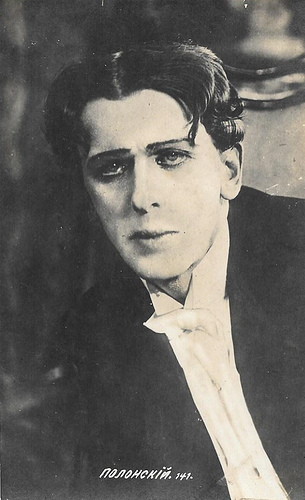
Russian postcard. Collection: Didier Hanson.
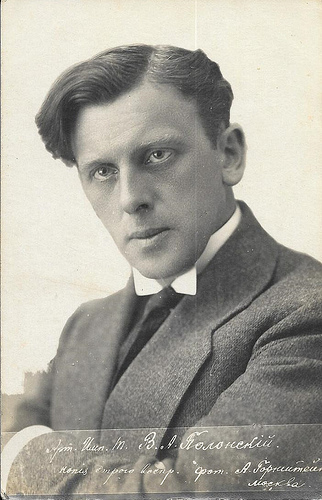
Russian postcard. Collection: Didier Hanson.
Hero-lover Roles
Vitold Alfonsovich Polonsky (Russian: Витольд Альфонсович Полонский) was born in Moscow in the Russian Empire in 1879.
The young Polonsky took drama courses in the Moscow theatre school, and graduated in 1907. He acted in the Maly Theatre in Moscow until 1916.
His first film role was Prince Andrey Bolkonsky opposite Vera Karalli in Natasha Rostova (Pyotr Chardynin, 1915) based on the novel by Leo Tolstoy. He also appeared opposite the other diva of the Russian silent cinema, Vera Kholodnaya , in Pesn torzhestvuyushchey lyubvi/Song of Triumphant Love (Yevgeni Bauer, 1915).
He played several hero-lover roles including Andrey Bargov in Posle smerti/After Death (Yevgeni Bauer, 1915); Prince Baratynsky in Zhizn za zhizn/A Life for a Life (Yevgeni Bauer, 1916); and Lanin in U kamina/By The Fireplace (Pyotr Chardynin, 1917). Polonsky became one of the most popular actors in pre-Revolutionary Russian cinema.
One of the most famous films of the era is the silent drama Molchi, grust... molchi/Be silent, sorrow ... be silent or Still, Sadness ... Still ... (Pyotr Chardynin, 1918) with a star-studded cast including Vera Kholodnaya , Ossip Runitsch , Vladimir Maksimov and Polonsky. This film consisted of two parts, but the first (44 minutes in length) survives.
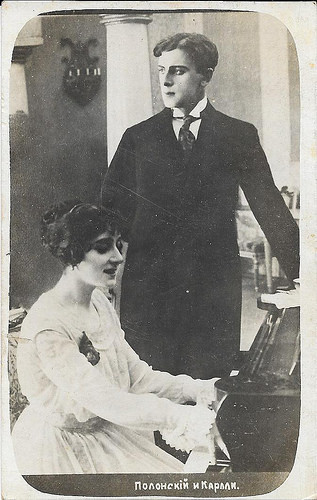
Russian postcard. Collection: Didier Hanson. Photo: publicity still for Vozmezdie/Retribution (Yevgeni Bauer, 1916) with Vera Kholodnaya .
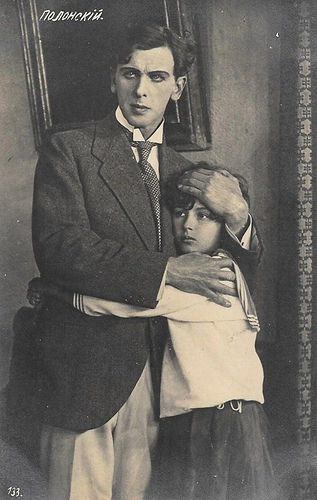
Russian postcard, no. 133. Collection: Didier Hanson.
Food poisoning
Vitold Polonsky was married twice. His first wife was the Maly Theatre actress Vera Nikolaevna Pashennaya, who became a National Artist of the USSR, a State Laureate and Lenin Prize winner. They had one daughter, Irina Polonskaya.
His second wife was Maly Theatre actress Olga Gladkova. They had one daughter, Veronika Polonskaya, who also became an actress.
In the summer of 1918, the film director Pyotr Chardynin and the Moscow cinema entrepreneur Dmitry Kharitonov requested the State Commissar for Education, Lunacharsky, to aid a group of cinema workers to travel to Odessa to film. They received a permit, and the group travelled to Odessa. Polonsky was part of the group along with Vera Kholodnaya and Ivan Mozzukhin .
In 1918, he directed the film Pesn lyubvi nedopetaya/Love Song Nedopetaya (1918) together with Lev Kuleshov. In November 1918, however, Odessa was occupied by the Entente forces (the Allies of World War I).
A few months later, in January 1919, Vitold Polonsky died from food poisoning.
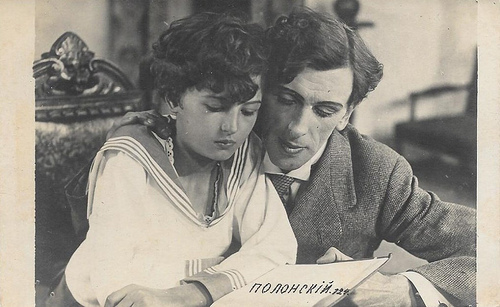
Russian postcard, no. 124. Collection: Didier Hanson.
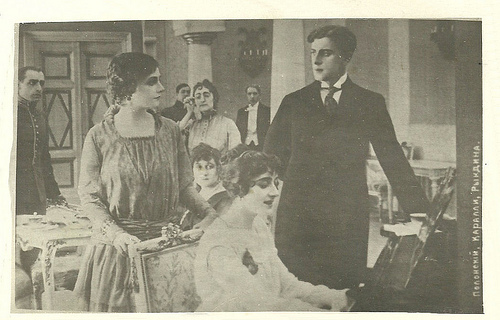
Russian postcard. Collection: Didier Hanson. Photo: publicity still for Vozmezdie/Retribution (1916, Yevgeni Bauer) with Lidia Ryndina and Vera Karalli .
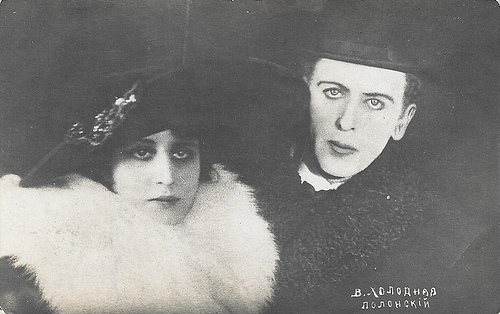
Russian postcard with Vera Kholodnaya . Collection: Didier Hanson.
Sources: Wikipedia and.

Russian postcard. Collection: Didier Hanson.

Russian postcard. Collection: Didier Hanson.
Hero-lover Roles
Vitold Alfonsovich Polonsky (Russian: Витольд Альфонсович Полонский) was born in Moscow in the Russian Empire in 1879.
The young Polonsky took drama courses in the Moscow theatre school, and graduated in 1907. He acted in the Maly Theatre in Moscow until 1916.
His first film role was Prince Andrey Bolkonsky opposite Vera Karalli in Natasha Rostova (Pyotr Chardynin, 1915) based on the novel by Leo Tolstoy. He also appeared opposite the other diva of the Russian silent cinema, Vera Kholodnaya , in Pesn torzhestvuyushchey lyubvi/Song of Triumphant Love (Yevgeni Bauer, 1915).
He played several hero-lover roles including Andrey Bargov in Posle smerti/After Death (Yevgeni Bauer, 1915); Prince Baratynsky in Zhizn za zhizn/A Life for a Life (Yevgeni Bauer, 1916); and Lanin in U kamina/By The Fireplace (Pyotr Chardynin, 1917). Polonsky became one of the most popular actors in pre-Revolutionary Russian cinema.
One of the most famous films of the era is the silent drama Molchi, grust... molchi/Be silent, sorrow ... be silent or Still, Sadness ... Still ... (Pyotr Chardynin, 1918) with a star-studded cast including Vera Kholodnaya , Ossip Runitsch , Vladimir Maksimov and Polonsky. This film consisted of two parts, but the first (44 minutes in length) survives.

Russian postcard. Collection: Didier Hanson. Photo: publicity still for Vozmezdie/Retribution (Yevgeni Bauer, 1916) with Vera Kholodnaya .

Russian postcard, no. 133. Collection: Didier Hanson.
Food poisoning
Vitold Polonsky was married twice. His first wife was the Maly Theatre actress Vera Nikolaevna Pashennaya, who became a National Artist of the USSR, a State Laureate and Lenin Prize winner. They had one daughter, Irina Polonskaya.
His second wife was Maly Theatre actress Olga Gladkova. They had one daughter, Veronika Polonskaya, who also became an actress.
In the summer of 1918, the film director Pyotr Chardynin and the Moscow cinema entrepreneur Dmitry Kharitonov requested the State Commissar for Education, Lunacharsky, to aid a group of cinema workers to travel to Odessa to film. They received a permit, and the group travelled to Odessa. Polonsky was part of the group along with Vera Kholodnaya and Ivan Mozzukhin .
In 1918, he directed the film Pesn lyubvi nedopetaya/Love Song Nedopetaya (1918) together with Lev Kuleshov. In November 1918, however, Odessa was occupied by the Entente forces (the Allies of World War I).
A few months later, in January 1919, Vitold Polonsky died from food poisoning.

Russian postcard, no. 124. Collection: Didier Hanson.

Russian postcard. Collection: Didier Hanson. Photo: publicity still for Vozmezdie/Retribution (1916, Yevgeni Bauer) with Lidia Ryndina and Vera Karalli .

Russian postcard with Vera Kholodnaya . Collection: Didier Hanson.
Sources: Wikipedia and.
Published on May 24, 2015 22:00
May 23, 2015
L'aigrette (1917)
L'aigrette/The egret (1917) is a silent Italian film by Baldassare Negroni. The film, produced by Tiber Film in Rome, was an adaptation by Negroni of a stage play by Dario Niccodemi. Stars were Hesperia, Tullio Carminati and André Habay.
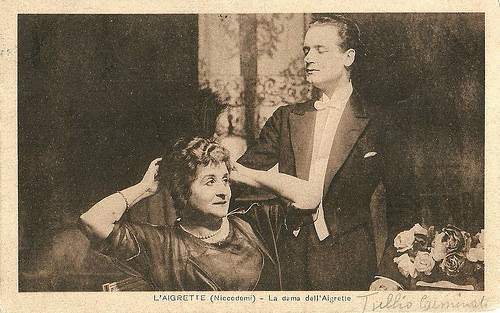
Italian postcard by IPA CT Duplex, no. 5103. Caption: La Dama dell'aigrette. (The lady of the egret) Photo: Tiber Film, Roma. Tullio Carminati and Ida Carloni Talli in the Italian silent film L'aigrette (Baldassarre Negroni, 1917).
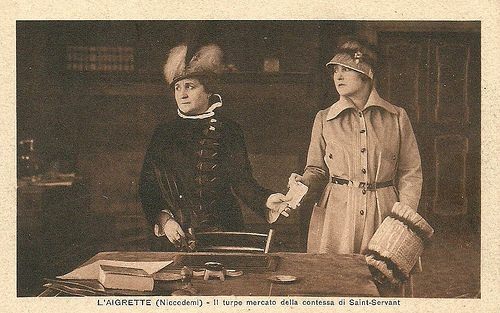
Italian postcard by IPA CT Duplex, no. 5105. Photo: Tiber Film, Roma. Caption: Il turpe mercato della contessa di Saint-Servant (The vile market of the Countess of Saint -Servant). Hesperia (at right) and Ida Carloni Talli in L'aigrette (Baldassarre Negroni, 1917).
Cherishing Honour and Virtue
The countess of Saint-Servant ( Ida Carloni Talli ) has raised her son Enrico ( Tullio Carminati ) to be proud of his name and title, and to cherish honour and virtue, symbolised by the feather of her aigrette (egret). In reality the countess is hunted by creditors, the castle is falling apart.
Enrico falls in love with Susanne Leblanc ( Hesperia ), wife of a banker, and in return she loads him with money in order to restore the family castle. Her husband Claudio ( André Habay ) is not so happy with this kind of charity...
L'aigrette was written as a comedy in three acts in 1912 and had been the first play by Dario Niccodemi. His comedies represent the bourgeois drama in an ironic and sentimental way, in which his characters are modelled on the society of the beginning of the century.
Niccodemi wrote several plays and screenplays. Films based on his work include L'ombra (Mario Caserini, 1917) with Vittoria Lepanto, La nemica/The enemy (Ivo Ulliminati, 1917) and Scampolo, filmed in 1917 with Margot Pellegrinetti, in 1928 with Carmen Boni , in 1932 with Dolly Haas , in 1941 with Lilia Silvi , and in 1958 with Romy Schneider .
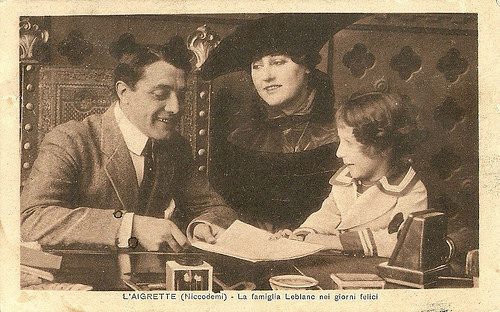
Italian postcard by IPA CT Duplex, no. 5107. Caption: La famiglia Leblanc nei gorni felici (The Leblanc family in happier days). Photo: Tiber Film, Roma. André Habay and Hesperia in the Italian silent film L'aigrette (Baldassarre Negroni, 1917).
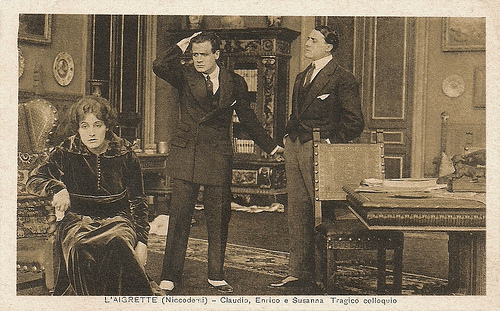
Italian postcard by IPA CT Duplex, no. 5108. Caption: Claudio, Enrico e Susanna. Tragico colloquio (Claudio, Enrico and Susanna. Tragic conversation). Photo: Tiber Film. Hesperia , Tullio Carminati and André Habay in the Italian silent film L'aigrette (Baldassarre Negroni, 1917).
A Wonderful Cast
L'aigrette had a wonderful cast with stars of the silent Italian cinema, like Tullio Carminati , André Habay , Diomira Jacobini (not pictured on one of the postcards), Ida Carloni Talli and of course in the leading role Hesperia .
Tullio Carminati (1895-1971) was an Italian stage and film actor with a long standing career from the 1910s to the 1960s. He played in Italian, German, American, British and French films as well as on Italian, American and British stages.
Italian actor André Habay (1883-1941) aka Andrea Habay (also written as Habaj or Kabaj) acted in modern dramas and diva films such as Sangue blu/Blue Blood (Nino Oxilia, 1914) and Rapsodia satanica/Satan's Rhapsody (Nino Oxilia, 1917). Later, he also starred as Petronius in the epic Quo vadis? (Gabriellino D'Annunzio, Georg Jacoby, 1925).
Ida Carloni Talli (1860-1940) was an important Italian stage actress, who also acted in 92 Italian silent films.
Hesperia (1885-1959), was one of the greatest divas of the Italian silent screen. She often worked with director Baldassarre Negroni, who later became her husband.
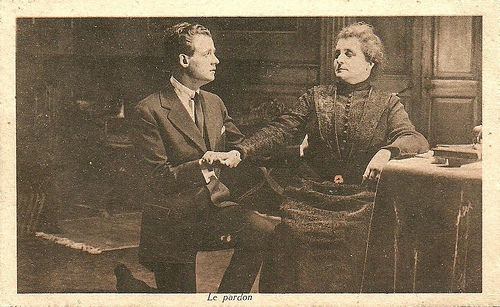
French postcard. Caption: Le pardon. (The pardon). Photo: Tullio Carminati and Ida Carloni-Talli in the Italian silent film L'aigrette (Baldassarre Negroni, 1917).
Sources: Wikipedia (Italian) and IMDb.

Italian postcard by IPA CT Duplex, no. 5103. Caption: La Dama dell'aigrette. (The lady of the egret) Photo: Tiber Film, Roma. Tullio Carminati and Ida Carloni Talli in the Italian silent film L'aigrette (Baldassarre Negroni, 1917).

Italian postcard by IPA CT Duplex, no. 5105. Photo: Tiber Film, Roma. Caption: Il turpe mercato della contessa di Saint-Servant (The vile market of the Countess of Saint -Servant). Hesperia (at right) and Ida Carloni Talli in L'aigrette (Baldassarre Negroni, 1917).
Cherishing Honour and Virtue
The countess of Saint-Servant ( Ida Carloni Talli ) has raised her son Enrico ( Tullio Carminati ) to be proud of his name and title, and to cherish honour and virtue, symbolised by the feather of her aigrette (egret). In reality the countess is hunted by creditors, the castle is falling apart.
Enrico falls in love with Susanne Leblanc ( Hesperia ), wife of a banker, and in return she loads him with money in order to restore the family castle. Her husband Claudio ( André Habay ) is not so happy with this kind of charity...
L'aigrette was written as a comedy in three acts in 1912 and had been the first play by Dario Niccodemi. His comedies represent the bourgeois drama in an ironic and sentimental way, in which his characters are modelled on the society of the beginning of the century.
Niccodemi wrote several plays and screenplays. Films based on his work include L'ombra (Mario Caserini, 1917) with Vittoria Lepanto, La nemica/The enemy (Ivo Ulliminati, 1917) and Scampolo, filmed in 1917 with Margot Pellegrinetti, in 1928 with Carmen Boni , in 1932 with Dolly Haas , in 1941 with Lilia Silvi , and in 1958 with Romy Schneider .

Italian postcard by IPA CT Duplex, no. 5107. Caption: La famiglia Leblanc nei gorni felici (The Leblanc family in happier days). Photo: Tiber Film, Roma. André Habay and Hesperia in the Italian silent film L'aigrette (Baldassarre Negroni, 1917).

Italian postcard by IPA CT Duplex, no. 5108. Caption: Claudio, Enrico e Susanna. Tragico colloquio (Claudio, Enrico and Susanna. Tragic conversation). Photo: Tiber Film. Hesperia , Tullio Carminati and André Habay in the Italian silent film L'aigrette (Baldassarre Negroni, 1917).
A Wonderful Cast
L'aigrette had a wonderful cast with stars of the silent Italian cinema, like Tullio Carminati , André Habay , Diomira Jacobini (not pictured on one of the postcards), Ida Carloni Talli and of course in the leading role Hesperia .
Tullio Carminati (1895-1971) was an Italian stage and film actor with a long standing career from the 1910s to the 1960s. He played in Italian, German, American, British and French films as well as on Italian, American and British stages.
Italian actor André Habay (1883-1941) aka Andrea Habay (also written as Habaj or Kabaj) acted in modern dramas and diva films such as Sangue blu/Blue Blood (Nino Oxilia, 1914) and Rapsodia satanica/Satan's Rhapsody (Nino Oxilia, 1917). Later, he also starred as Petronius in the epic Quo vadis? (Gabriellino D'Annunzio, Georg Jacoby, 1925).
Ida Carloni Talli (1860-1940) was an important Italian stage actress, who also acted in 92 Italian silent films.
Hesperia (1885-1959), was one of the greatest divas of the Italian silent screen. She often worked with director Baldassarre Negroni, who later became her husband.

French postcard. Caption: Le pardon. (The pardon). Photo: Tullio Carminati and Ida Carloni-Talli in the Italian silent film L'aigrette (Baldassarre Negroni, 1917).
Sources: Wikipedia (Italian) and IMDb.
Published on May 23, 2015 22:00
May 22, 2015
ABBA
Tonight is the final of the Eurovision Song Contest 2015. For non-Europeans: the Eurovision Song Contest has been broadcast every year since the start in 1956. So it is one of the longest-running television programmes in the world, but also one of the most watched non-sporting events, with audience figures somewhere between 100 million and 600 million internationally. Artists whose international careers were launched at Eurovision include Italian Domenico Modugno of the evergreen Volare in 1958, Céline Dion, who won for Switzerland in 1988 with the French-language song Ne partez pas sans moi (Don't leave without me), and the Spaniard Julio Iglesias, who has since sold over 300 million records worldwide. But the post today is about our favourite winner ever - ABBA. They won the contest for Sweden in 1974 with Waterloo.
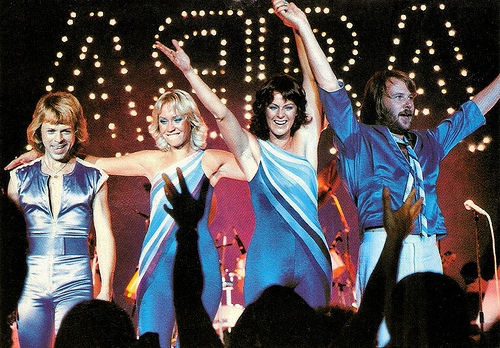
German postcard by Polar Music International AB, SIB-tryck AB 1980. Photo: A. Hanser / Polar Music International AB.
First victory
In 1974, ABBA gave Sweden its first victory in the history of the Eurovision Song Contest. They are also the most successful group ever to take part in the tournament.
The Swedish group was formed in Stockholm in 1972, and comprised blond Agnetha Fältskog, Björn Ulvaeus, Benny Andersson (with moustache and beard), and dark-haired Anni-Frid Lyngstad. ABBA is an acronym of the first letters of their first names.
They became one of the most commercially successful acts in the history of popular music, topping the charts worldwide from 1972 to 1982. ABBA has sold over 381 million albums and singles worldwide and continue to sell millions of records a year.
During the band's active years, Fältskog and Ulvaeus were married, as were Lyngstad and Andersson, although both couples later divorced. At the height of their popularity, both relationships were suffering strain which ultimately resulted in the collapse of the Ulvaeus–Fältskog marriage in 1979 and the Andersson–Lyngstad marriage in 1981.
These relationship changes were reflected in the group's music, with later compositions including more introspective, brooding, dark lyrics.
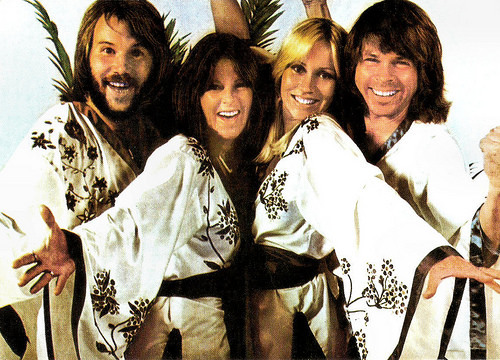
Romanian postcard by Casa Filmului Acin.
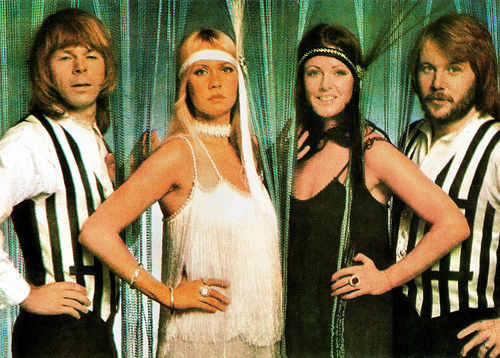
Romanian postcard by Casa Filmului Acin.
Before ABBA
Benny Andersson (1946, Stockholm, Sweden) became at age 18 a member of the popular Swedish pop-rock group the Hep Stars, known as 'the Swedish Beatles'. Andersson played the keyboard and eventually started writing original songs for his band, many of which became major hits in 1966.
Björn Ulvaeus (1945, Göteborg, Sweden) also began his musical career at 18, as a singer and guitarist for the folk-skiffle group The Hootenanny Singers. He started writing English-language songs for his group, and even had a brief solo career alongside. In June 1966, Ulvaeus and Andersson decided to write a song together. Their first attempt was Isn't It Easy to Say.
Stig Anderson was the manager of The Hootenanny Singers and founder of the Polar Music label. He saw potential in the collaboration, and encouraged them to write more. Both also began playing occasionally with the other's bands on stage and on record, although it was not until 1969 that the pair wrote and produced some of their first real hits together: Ljuva sextital (Sweet Sixties), recorded by Brita Borg, and The Hep Stars' 1969 hit Speleman (Fiddler).
Andersson wrote and submitted the song Hej, Clown for the 1969 Melodifestivalen, the national festival to select the Swedish entry to the Eurovision Song Contest. The song tied for first place, but re-voting relegated Andersson's song to second place. On that occasion Andersson briefly met his future spouse, singer Anni-Frid 'Frida' Lyngstad (1945, Bjørkåsen, Norway), who also participated in the contest. A month later, the two had become a couple. As their respective bands began to break up during 1969, Andersson and Ulvaeus teamed up and recorded their first album together in 1970, called Lycka (Happiness), which included original songs sung by both men. In 1971, Frida had her first number 1 single, Min egen stad (My Own Town) written by Benny featuring all the future ABBA members on backing vocals.
Agnetha Fältskog (1950, Jönköping, Sweden) sang with a local dance band headed by Bernt Enghardt who sent a demo recording of the band to Karl Gerhard Lundkvist. This led to Agnetha at the age of 18 having a number 1 record in Sweden with a self-composed song. Agnetha released four solo LPs between 1968 and 1971. She had many successful singles in the Swedish charts. They were often self-composed, which was quite unusual for a female singer in the 1960s. During filming of a Swedish TV special in 1969, Fältskog met Ulvaeus, and they married in 1971. In 1972, she starred as Mary Magdalene in the original Swedish production of Jesus Christ Superstar, to favourable reviews.
Hej, gamle man, a song about an old Salvation Army soldier, became the quartet's first hit. The record was credited to Björn & Benny and reached number 5 on the sales charts and number 1 on Svensktoppen, the weekly record chart airing at Sveriges Radio, staying there for 15 weeks. Stig Anderson was determined to break into the mainstream international market with music by Andersson and Ulvaeus.
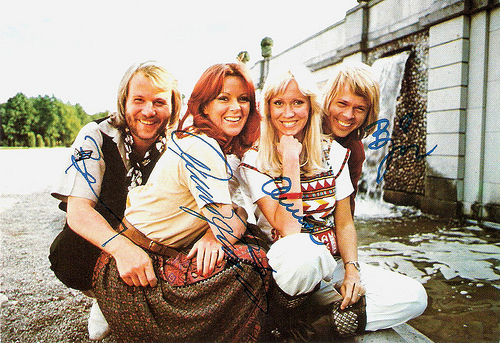
German promotion card by Polydor.
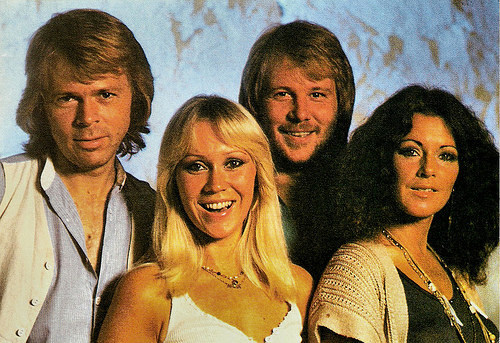
Swedish postcard by Ultraförlaget A.B., Stockholm, no. 28 - 012. Photo: Torbjörn Calvero.
The Eurovision Song Contest
Manager Stig Anderson encouraged Bjorn Ulvaeus and Benny Andersson to write a song for Melodifestivalen, the annual music competition in Sweden which determines the country's representative for the Eurovision Song Contest. After two rejected entries in 1971, Andersson and Ulvaeus submitted their new song Säg det med en sång (Say It with a Song) for the 1972 contest, choosing newcomer Lena Anderson to perform. The song came in third place and became a hit in Sweden.
Ulvaeus and Andersson experimented with new sounds and vocal arrangements. People Need Love was released in June 1972, featuring guest vocals by Agnetha Fältskog and Anni-Frid Lyngstad, who were now given much greater prominence. Stig Anderson released it as a single, credited to Björn & Benny, Agnetha & Anni-Frid. The song peaked at number 17 in the Swedish combined single and album charts, enough to convince them they were on to something. The single also became the first record to chart for the quartet in the United States, where it peaked at number 114 on the Cashbox singles chart and number 117 on the Record World singles chart.
The foursome decided to record their first album together in the autumn of 1972, and sessions began on 26 September 1972. Agnetha Fältskog and Anni-Frid Lyngstad shared lead vocals on Nina, Pretty Ballerina (a top ten hit in Austria) that day, and their voices in harmony for the first time gave the foursome an idea of the quality of their combined talents.
In 1973, the band and their manager Stig Anderson decided to have another try at Melodifestivalen, this time with the song Ring Ring. The studio sessions were handled by Michael B. Tretow, who experimented with a 'wall of sound' production technique that became the wholly new sound. Stig Anderson arranged an English translation of the lyrics by Neil Sedaka and Phil Cody and they thought this would be a sure-fire winner. However in 1973, the song came third in Melodifestivalen. Nevertheless, Ring Ring was a hit in many parts of Europe and also in South Africa, but Stig Anderson felt that the true breakthrough could only come with a UK or US hit.
In early 1973, Stig Anderson started to refer to the group privately and publicly as ABBA and in the summer the name became official. Ulvaeus, Andersson and Stig Anderson believed in the possibilities of using the Eurovision Song Contest as a way to make the music business aware of them as songwriters, as well as the band itself. In late 1973, they were invited by Swedish television to contribute a song for the Melodifestivalen 1974 and from a number of new songs, the upbeat number Waterloo was chosen. The group was now inspired by the growing glam rock scene in England.
ABBA won their national heats on Swedish television on 9 February 1974, and with this third attempt were far more experienced and better prepared for the Eurovision Song Contest. Winning the 1974 Contest on 6 April 1974 gave ABBA the chance to tour Europe and perform on major television shows. Waterloo was ABBA's first number one single in big markets such as the UK and West Germany. In the United States, the song peaked at number six on the Billboard Hot 100 chart, paving the way for their first album and their first trip as a group there.
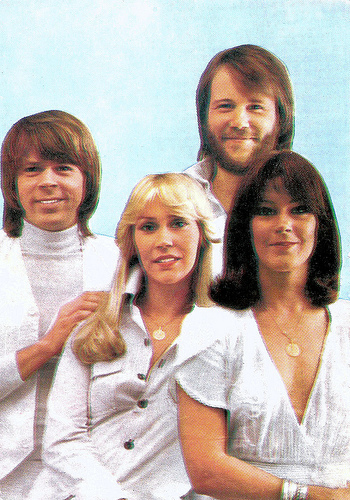
Romanian postcard by Casa Filmului Acin.
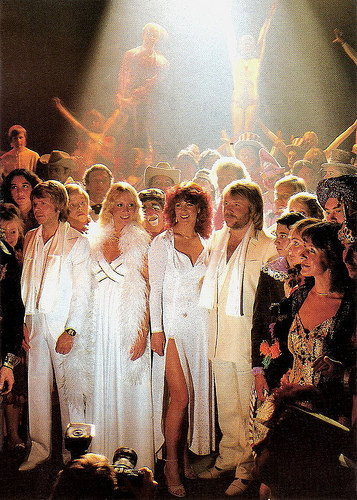
German postcard by Polar Music International AB, SIB-tryck AB. Photo: Polar Music International AB. Publicity still for the album Super Trouper (1980).
After ABBA
ABBA has never officially announced the end of the group, but it has long been considered dissolved. Their final public performance together as ABBA was on the British TV programme The Late, Late Breakfast Show (live from Stockholm) on 11 December 1982. In January 1983, Fältskog started recording sessions for a solo album, as Lyngstad had successfully released her album Something's Going On some months earlier. Ulvaeus and Andersson, meanwhile, started songwriting sessions for the musical Chess. Except for a TV appearance in 1986, the foursome did not come together publicly again until they were reunited at the Swedish premiere of the Mamma Mia! film in 2008.
In October 1984, Bjorn Ulvaeus and Benny Andersson together with lyricist Tim Rice released the musical concept double album Chess. The singles One Night in Bangkok (with vocals by Murray Head and Anders Glenmark) and I Know Him So Well (a duet by Barbara Dickson and Elaine Paige, and later also recorded by both Barbra Streisand and Whitney Houston) were both hugely successful. In May 1986, the musical premièred in London's West End, and ran for almost three years. Chess also opened on Broadway in April 1988, but closed within two months due to bad reviews.
Andersson and Ulvaeus' next project, Kristina från Duvemåla, an epic Swedish musical, premiered in Malmö, in southern Sweden in 1995. The musical ran for five years in Stockholm, and an English version has been in development for some considerable time. Andersson and Ulvaeus have continued writing songs for the Swedish duo Gemini in 1985 and 1987. Benny Andersson has also regularly written music for films like Roy Andersson's Sånger från andra våningen/Songs from the Second Floor (2000). In 2001, Benny formed his own band, Benny Anderssons Orkester (BAO), which released three successful albums.
Bjorn Ulvaeus and Benny Andersson have been highly involved in the worldwide productions of the musical Mamma Mia!, alongside Lyngstad who attends premieres. They were also involved in the production of the successful film version of the musical, which opened 2008. Andersson produced the soundtrack utilising many of the musicians ABBA used on their albums and tours. Andersson made a cameo appearance in the film Mamma Mia! (Phyllida Lloyd, 2008) as a 'fisherman' piano player in the Dancing Queen scene, while Ulvaeus is seen as a Greek god playing a lyre during the closing credits.
Both Agnetha Fältskog and Anni-Frid Lyngstad pursued solo careers on the international scene after their work with the group. Lyngstad acted in two films, Gå på vattnet om du kan/Walk on Water If You Can (Stig Björkman, 1979) with Lena Nyman, and the comedy Jokerfejs (Peter Wester, 1984). In 1982, Lyngstad chose Genesis drummer and vocalist Phil Collins to produce the album Something's Going On. The single I Know There's Something Going On became a number 1 hit in a.o. France, Belgium and Switzerland. Lyngstad's second solo album after ABBA was called Shine (1984), produced by Steve Lillywhite. It was her final studio album release for twelve years.
In 1980, Agnetha Fältskog recorded Nu tändas tusen juleljus (Now a thousand Christmas candles are lit), a Swedish Christmas album along with her 7 year old daughter Linda. The album peaked at No. 6 on the Swedish album chart in January 1982 and is one of the best-selling Swedish Christmas albums of all time. In 1983, Fältskog released the solo album Wrap Your Arms Around Me produced by Mike Chapman. This included the single The Heat Is On, which was a hit all over Europe and Scandinavia. In the United States, Fältskog earned a Billboard Top 30 hit with Can't Shake Loose. In 1983, she also starred in the Swedish comedy Raskenstam/Casanova of Sweden (Gunnar Hellström, 1983), a critical and box office success. Fältskog's second English-language solo album, Eyes of a Woman (1985) peaked at number 2 in Sweden and performed reasonably well in Europe. The album was produced by Eric Stewart of 10cc.
From 1992 to 1995, Anni-Frid Lyngstad was chairperson for the environmental organisation Artister för miljön (Artists for the Environment) in Sweden. Her environmental work for this organisation led up to the decision to record again. The album Djupa andetag (Deep Breaths) was released towards the end of 1996 and became a success in Sweden, where it reached number 1. Shelives a relatively low-profile life but occasionally appears at a party or charity function. On 26 August 1992, she married Prince Heinrich Ruzzo Reuss von Plauen, of the German Reuss family. Von Plauen died of lymphoma in 1999 at the age of 49. In addition to losing her husband, Lyngstad had also lost her daughter Lise-Lotte in a car crash a year earlier.
In early 1987, Agnetha Fältskog recorded an album Kom följ med I vår karusell (Come ride with me on my carousel) with her son Christian. The album contained songs for children and was sung in Swedish. In November 1987, Fältskog released her third post-ABBA solo album, the Peter Cetera-produced I Stand Alone. The album spent eight weeks at number 1 in Sweden. Shortly after some minor European promotion for the album in early 1988, Fältskog withdrew from public life and halted her music career. In 1996, she released her autobiography, As I Am, and a compilation album featuring her solo hits alongside some ABBA classics. In 2004, she made a successful comeback, releasing the critically acclaimed album My Colouring Book. In May 2013, Fältskog released a solo album entitled A through the Verve music label.
Clip of Ring, Ring (1973). Source: AbbaVevo (YouTube).
ABBA singing Waterloo at the Eurovision Song Contest 1974. Source: Mozpiano2 (YouTube).
Trailer Abba The Movie (Lasse Hallström, 1977). Source: CinemaTerrorDotCom (YouTube).
Clip of The Winner Takes It All (1980). Source: AbbaVevo (YouTube).
Sources: Wikipedia and IMDb.

German postcard by Polar Music International AB, SIB-tryck AB 1980. Photo: A. Hanser / Polar Music International AB.
First victory
In 1974, ABBA gave Sweden its first victory in the history of the Eurovision Song Contest. They are also the most successful group ever to take part in the tournament.
The Swedish group was formed in Stockholm in 1972, and comprised blond Agnetha Fältskog, Björn Ulvaeus, Benny Andersson (with moustache and beard), and dark-haired Anni-Frid Lyngstad. ABBA is an acronym of the first letters of their first names.
They became one of the most commercially successful acts in the history of popular music, topping the charts worldwide from 1972 to 1982. ABBA has sold over 381 million albums and singles worldwide and continue to sell millions of records a year.
During the band's active years, Fältskog and Ulvaeus were married, as were Lyngstad and Andersson, although both couples later divorced. At the height of their popularity, both relationships were suffering strain which ultimately resulted in the collapse of the Ulvaeus–Fältskog marriage in 1979 and the Andersson–Lyngstad marriage in 1981.
These relationship changes were reflected in the group's music, with later compositions including more introspective, brooding, dark lyrics.

Romanian postcard by Casa Filmului Acin.

Romanian postcard by Casa Filmului Acin.
Before ABBA
Benny Andersson (1946, Stockholm, Sweden) became at age 18 a member of the popular Swedish pop-rock group the Hep Stars, known as 'the Swedish Beatles'. Andersson played the keyboard and eventually started writing original songs for his band, many of which became major hits in 1966.
Björn Ulvaeus (1945, Göteborg, Sweden) also began his musical career at 18, as a singer and guitarist for the folk-skiffle group The Hootenanny Singers. He started writing English-language songs for his group, and even had a brief solo career alongside. In June 1966, Ulvaeus and Andersson decided to write a song together. Their first attempt was Isn't It Easy to Say.
Stig Anderson was the manager of The Hootenanny Singers and founder of the Polar Music label. He saw potential in the collaboration, and encouraged them to write more. Both also began playing occasionally with the other's bands on stage and on record, although it was not until 1969 that the pair wrote and produced some of their first real hits together: Ljuva sextital (Sweet Sixties), recorded by Brita Borg, and The Hep Stars' 1969 hit Speleman (Fiddler).
Andersson wrote and submitted the song Hej, Clown for the 1969 Melodifestivalen, the national festival to select the Swedish entry to the Eurovision Song Contest. The song tied for first place, but re-voting relegated Andersson's song to second place. On that occasion Andersson briefly met his future spouse, singer Anni-Frid 'Frida' Lyngstad (1945, Bjørkåsen, Norway), who also participated in the contest. A month later, the two had become a couple. As their respective bands began to break up during 1969, Andersson and Ulvaeus teamed up and recorded their first album together in 1970, called Lycka (Happiness), which included original songs sung by both men. In 1971, Frida had her first number 1 single, Min egen stad (My Own Town) written by Benny featuring all the future ABBA members on backing vocals.
Agnetha Fältskog (1950, Jönköping, Sweden) sang with a local dance band headed by Bernt Enghardt who sent a demo recording of the band to Karl Gerhard Lundkvist. This led to Agnetha at the age of 18 having a number 1 record in Sweden with a self-composed song. Agnetha released four solo LPs between 1968 and 1971. She had many successful singles in the Swedish charts. They were often self-composed, which was quite unusual for a female singer in the 1960s. During filming of a Swedish TV special in 1969, Fältskog met Ulvaeus, and they married in 1971. In 1972, she starred as Mary Magdalene in the original Swedish production of Jesus Christ Superstar, to favourable reviews.
Hej, gamle man, a song about an old Salvation Army soldier, became the quartet's first hit. The record was credited to Björn & Benny and reached number 5 on the sales charts and number 1 on Svensktoppen, the weekly record chart airing at Sveriges Radio, staying there for 15 weeks. Stig Anderson was determined to break into the mainstream international market with music by Andersson and Ulvaeus.

German promotion card by Polydor.

Swedish postcard by Ultraförlaget A.B., Stockholm, no. 28 - 012. Photo: Torbjörn Calvero.
The Eurovision Song Contest
Manager Stig Anderson encouraged Bjorn Ulvaeus and Benny Andersson to write a song for Melodifestivalen, the annual music competition in Sweden which determines the country's representative for the Eurovision Song Contest. After two rejected entries in 1971, Andersson and Ulvaeus submitted their new song Säg det med en sång (Say It with a Song) for the 1972 contest, choosing newcomer Lena Anderson to perform. The song came in third place and became a hit in Sweden.
Ulvaeus and Andersson experimented with new sounds and vocal arrangements. People Need Love was released in June 1972, featuring guest vocals by Agnetha Fältskog and Anni-Frid Lyngstad, who were now given much greater prominence. Stig Anderson released it as a single, credited to Björn & Benny, Agnetha & Anni-Frid. The song peaked at number 17 in the Swedish combined single and album charts, enough to convince them they were on to something. The single also became the first record to chart for the quartet in the United States, where it peaked at number 114 on the Cashbox singles chart and number 117 on the Record World singles chart.
The foursome decided to record their first album together in the autumn of 1972, and sessions began on 26 September 1972. Agnetha Fältskog and Anni-Frid Lyngstad shared lead vocals on Nina, Pretty Ballerina (a top ten hit in Austria) that day, and their voices in harmony for the first time gave the foursome an idea of the quality of their combined talents.
In 1973, the band and their manager Stig Anderson decided to have another try at Melodifestivalen, this time with the song Ring Ring. The studio sessions were handled by Michael B. Tretow, who experimented with a 'wall of sound' production technique that became the wholly new sound. Stig Anderson arranged an English translation of the lyrics by Neil Sedaka and Phil Cody and they thought this would be a sure-fire winner. However in 1973, the song came third in Melodifestivalen. Nevertheless, Ring Ring was a hit in many parts of Europe and also in South Africa, but Stig Anderson felt that the true breakthrough could only come with a UK or US hit.
In early 1973, Stig Anderson started to refer to the group privately and publicly as ABBA and in the summer the name became official. Ulvaeus, Andersson and Stig Anderson believed in the possibilities of using the Eurovision Song Contest as a way to make the music business aware of them as songwriters, as well as the band itself. In late 1973, they were invited by Swedish television to contribute a song for the Melodifestivalen 1974 and from a number of new songs, the upbeat number Waterloo was chosen. The group was now inspired by the growing glam rock scene in England.
ABBA won their national heats on Swedish television on 9 February 1974, and with this third attempt were far more experienced and better prepared for the Eurovision Song Contest. Winning the 1974 Contest on 6 April 1974 gave ABBA the chance to tour Europe and perform on major television shows. Waterloo was ABBA's first number one single in big markets such as the UK and West Germany. In the United States, the song peaked at number six on the Billboard Hot 100 chart, paving the way for their first album and their first trip as a group there.

Romanian postcard by Casa Filmului Acin.

German postcard by Polar Music International AB, SIB-tryck AB. Photo: Polar Music International AB. Publicity still for the album Super Trouper (1980).
After ABBA
ABBA has never officially announced the end of the group, but it has long been considered dissolved. Their final public performance together as ABBA was on the British TV programme The Late, Late Breakfast Show (live from Stockholm) on 11 December 1982. In January 1983, Fältskog started recording sessions for a solo album, as Lyngstad had successfully released her album Something's Going On some months earlier. Ulvaeus and Andersson, meanwhile, started songwriting sessions for the musical Chess. Except for a TV appearance in 1986, the foursome did not come together publicly again until they were reunited at the Swedish premiere of the Mamma Mia! film in 2008.
In October 1984, Bjorn Ulvaeus and Benny Andersson together with lyricist Tim Rice released the musical concept double album Chess. The singles One Night in Bangkok (with vocals by Murray Head and Anders Glenmark) and I Know Him So Well (a duet by Barbara Dickson and Elaine Paige, and later also recorded by both Barbra Streisand and Whitney Houston) were both hugely successful. In May 1986, the musical premièred in London's West End, and ran for almost three years. Chess also opened on Broadway in April 1988, but closed within two months due to bad reviews.
Andersson and Ulvaeus' next project, Kristina från Duvemåla, an epic Swedish musical, premiered in Malmö, in southern Sweden in 1995. The musical ran for five years in Stockholm, and an English version has been in development for some considerable time. Andersson and Ulvaeus have continued writing songs for the Swedish duo Gemini in 1985 and 1987. Benny Andersson has also regularly written music for films like Roy Andersson's Sånger från andra våningen/Songs from the Second Floor (2000). In 2001, Benny formed his own band, Benny Anderssons Orkester (BAO), which released three successful albums.
Bjorn Ulvaeus and Benny Andersson have been highly involved in the worldwide productions of the musical Mamma Mia!, alongside Lyngstad who attends premieres. They were also involved in the production of the successful film version of the musical, which opened 2008. Andersson produced the soundtrack utilising many of the musicians ABBA used on their albums and tours. Andersson made a cameo appearance in the film Mamma Mia! (Phyllida Lloyd, 2008) as a 'fisherman' piano player in the Dancing Queen scene, while Ulvaeus is seen as a Greek god playing a lyre during the closing credits.
Both Agnetha Fältskog and Anni-Frid Lyngstad pursued solo careers on the international scene after their work with the group. Lyngstad acted in two films, Gå på vattnet om du kan/Walk on Water If You Can (Stig Björkman, 1979) with Lena Nyman, and the comedy Jokerfejs (Peter Wester, 1984). In 1982, Lyngstad chose Genesis drummer and vocalist Phil Collins to produce the album Something's Going On. The single I Know There's Something Going On became a number 1 hit in a.o. France, Belgium and Switzerland. Lyngstad's second solo album after ABBA was called Shine (1984), produced by Steve Lillywhite. It was her final studio album release for twelve years.
In 1980, Agnetha Fältskog recorded Nu tändas tusen juleljus (Now a thousand Christmas candles are lit), a Swedish Christmas album along with her 7 year old daughter Linda. The album peaked at No. 6 on the Swedish album chart in January 1982 and is one of the best-selling Swedish Christmas albums of all time. In 1983, Fältskog released the solo album Wrap Your Arms Around Me produced by Mike Chapman. This included the single The Heat Is On, which was a hit all over Europe and Scandinavia. In the United States, Fältskog earned a Billboard Top 30 hit with Can't Shake Loose. In 1983, she also starred in the Swedish comedy Raskenstam/Casanova of Sweden (Gunnar Hellström, 1983), a critical and box office success. Fältskog's second English-language solo album, Eyes of a Woman (1985) peaked at number 2 in Sweden and performed reasonably well in Europe. The album was produced by Eric Stewart of 10cc.
From 1992 to 1995, Anni-Frid Lyngstad was chairperson for the environmental organisation Artister för miljön (Artists for the Environment) in Sweden. Her environmental work for this organisation led up to the decision to record again. The album Djupa andetag (Deep Breaths) was released towards the end of 1996 and became a success in Sweden, where it reached number 1. Shelives a relatively low-profile life but occasionally appears at a party or charity function. On 26 August 1992, she married Prince Heinrich Ruzzo Reuss von Plauen, of the German Reuss family. Von Plauen died of lymphoma in 1999 at the age of 49. In addition to losing her husband, Lyngstad had also lost her daughter Lise-Lotte in a car crash a year earlier.
In early 1987, Agnetha Fältskog recorded an album Kom följ med I vår karusell (Come ride with me on my carousel) with her son Christian. The album contained songs for children and was sung in Swedish. In November 1987, Fältskog released her third post-ABBA solo album, the Peter Cetera-produced I Stand Alone. The album spent eight weeks at number 1 in Sweden. Shortly after some minor European promotion for the album in early 1988, Fältskog withdrew from public life and halted her music career. In 1996, she released her autobiography, As I Am, and a compilation album featuring her solo hits alongside some ABBA classics. In 2004, she made a successful comeback, releasing the critically acclaimed album My Colouring Book. In May 2013, Fältskog released a solo album entitled A through the Verve music label.
Clip of Ring, Ring (1973). Source: AbbaVevo (YouTube).
ABBA singing Waterloo at the Eurovision Song Contest 1974. Source: Mozpiano2 (YouTube).
Trailer Abba The Movie (Lasse Hallström, 1977). Source: CinemaTerrorDotCom (YouTube).
Clip of The Winner Takes It All (1980). Source: AbbaVevo (YouTube).
Sources: Wikipedia and IMDb.
Published on May 22, 2015 22:00
May 21, 2015
Michael Caine
With his spectacles and his Cockney accent, Michael Caine (1930) became an unusual but ultra cool star of the British cinema of the 1960s. He starred in memorable films like Alfie (1966), The Italian Job (1969), and Get Carter (1971). The lean and tall Brit branched out to Hollywood where his film choices often seemed dictated by his checkbook. Caine proved to be endurable and a new generation of film fans love him for his mentors and father figures in blockbusters like The Dark Knight trilogy, Inception (2010) and Interstellar (2014).
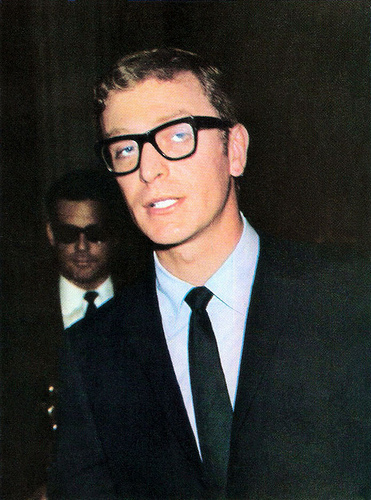
Yugoslavian postcard by Cik Razglednica.
The working-class bloke with glasses and a down-home accent
In 1930, Michael Caine was born Maurice Joseph Micklewhite in London, to Ellen Frances Marie Micklewhite-Burchell, a cook and charlady, and Maurice Joseph Micklewhite, a fish-market porter. He has two brothers. Younger brother Stanley Caine appeared in at least three of Caine's films: Billion Dollar Brain (1967), Play Dirty (1969) and The Italian Job (1969). He did not know about his elder half-brother David until their mother died in 1989. For more than forty years, Caine's mother had paid periodic visits to a ‘cousin’ in a mental hospital. David suffered from epilepsy and lived till his death in 1992 in the hospital.
Michael left school at 15 and took a series of working-class jobs before joining the British army and serving in Korea during the Korean War, where he saw combat. Upon his return to England the 20-years-old Caine gravitated toward the theatre and got a job as an assistant stage manager. He adopted the name of Caine on the advice of his agent, taking it from a marquee of the Odeon Cinema that advertised The Caine Mutiny (Edward Dmytryk, 1954).
In the years that followed he worked in more than 100 television dramas, with repertory companies throughout England and eventually in Lindsay Anderson's West End staging of Willis Hall's The Long and the Short and the Tall (1959). He was Peter O'Toole 's understudy in that stage hit and took over the role when O'Toole left to make Lawrence of Arabia (David Lean, 1962).
Caine's first film role was as one of the privates in Stanley Baker 's platoon in the British war film A Hill in Korea (Julien Amyes, 1956). A big break came for Caine when he was cast in the Cockney stage comedy Next Time I'll Sing To You (1963). He was visited backstage by Stanley Baker , the star of A Hill in Korea, who asked him for his upcoming film Zulu, a film Baker was producing and starring in. Zulu (Cy Endfield, 1964) is the epic retelling of a historic 19th-century battle in South Africa between British soldiers and Zulu warriors. Instead of being typecast as a low-ranking Cockney soldier, he played a snobbish, aristocratic officer.
Zulu was a major success, but it was the role of the spy Harry Palmer in The Ipcress File (Sidney J. Furie, 1965) and the young womanizer in Alfie (Lewis Gilbert, 1966) that made Caine a major star. He epitomized the new breed of actor in mid-1960s England, the working-class bloke with glasses and a down-home accent.
Some excellent films followed including his American debut Gambit (Ronald Neame, 1966) with Shirley MacLaine, the Harry Palmer spy film Funeral in Berlin (Guy Hamilton, 1966), the caper The Italian Job (Peter Collinson, 1969) with Noël Coward, Battle of Britain (Guy Hamilton, 1969), and especially the crime film Get Carter (Mike Hodges, 1971) and the mystery thriller Sleuth (Joseph L. Mankiewicz, 1972) with Laurence Olivier , for which he earned his second Oscar nomination.
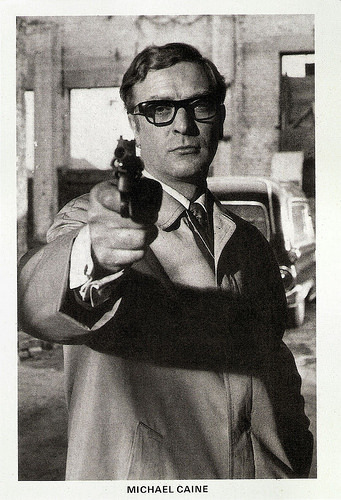
Spanish postcard by Productos Compactos S.A. Photo: publicity still for The Ipcress File (Sidney J. Furie, 1965).
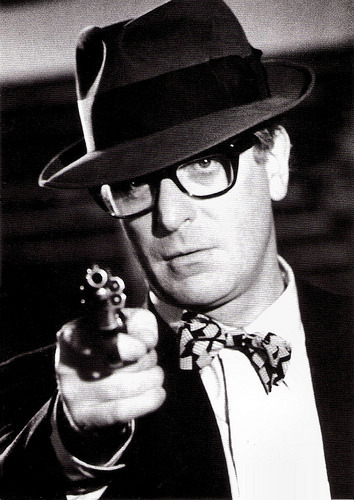
British postcard by Boomerang. Photo: Everett Collection.
What's it all about?
During the bigger part of the 1970s, Michael Caine seemed to take on roles in below-average films, simply for the money he could by then command. There were some gems amongst the dross, however. He gave a magnificent performance opposite Sean Connery in The Man Who Would Be King (John Huston, 1975) and turned in a solid one as the commander of a Luftwaffe paratroop unit planning to kidnap Winston Churchill in The Eagle Has Landed (John Sturges, 1976). Caine also was part of an all-star cast in A Bridge Too Far (Richard Attenborough, 1977), was part of the ensemble in the comedy California Suite (Herbert Ross, 1978), and slashed Angie Dickenson in the thriller Dressed to Kill (Brian De Palma, 1980).
Highlights during the 1980s were Educating Rita (Lewis Gilbert, 1983), earning him the BAFTA and Golden Globe Award for Best Actor, and Hannah and Her Sisters (Woody Allen, 1986), for which he won his first Oscar for Best Supporting Actor. He was not present at the Academy Awards ceremony because he was filming Jaws: The Revenge (Joseph Sargent, 1987), for which he was nominated for worst supporting actor at the 1988 Razzie awards.
His other successful films were the war film Escape to Victory (John Huston, 1981), the Ira Levin thriller Deathtrap (Sidney Lumet, 1982), and the beautiful neo-noir mystery Mona Lisa (Neil Jordan, 1986) with Bob Hoskins. Caine was excellent as Ebenezer Scrooge in The Muppet Christmas Carol (Brian Henson, 1992). In 1992, he also published the autobiography What's it all about? It was a decade later followed by The Elephant to Hollywood (2012). He was awarded the CBE (Commander Of The Order Of The British Empire) in the 1993 Queen's Honours List for his services to drama.
Having by that time practically retired from acting on the big screen, he enjoyed a career resurgence in the late 1990s. He received a Golden Globe Award for his performance in the musical Little Voice (Mark Herman, 1998) and his second Academy Award for Best Supporting Actor for The Cider House Rules (Lasse Hallström, 1999). In 2000, he was awarded a Knight Bachelor of the Order of the British Empire.
In the last decades, he often played mentors and father figures to younger characters in films. In every film Caine made with director Christopher Nolan, his character either assists, guides, trains or educates the protagonist. In The Prestige (2006), Caine portrayed a magician who teaches the main character the art of illusion. For Nolan’s Dark Knight trilogy - Batman Begins (2005), The Dark Knight (2008) and The Dark Knight Rises (2012) - Caine played the supporting and nurturing butler Alfred Pennyworth to Bruce Wayne aka Batman (Christian Bale). For Inception (2010), Caine depicted the father of the main protagonist, Cobb, and aids him by recruiting one of his students. In Interstellar (2014), Caine portrays a professor/engineer, who invites and encourages the central character, Cooper, to lead an important space mission that will determine the future of planet earth.
Among his other more recent films that have been widely acclaimed are the British/German drama Last Orders (Fred Schepisi, 2001) with Tom Courtenay, the parody Austin Powers in Goldmember (Jay Roach, 2002) as Austin’s father, the Graham Greene adaptation The Quiet American (Phillip Noyce, 2002) with Brendan Fraser, Children of Men (Alfonso Cuarón, 2006) and Pixar's Cars 2 (John Lasseter, 2011). In the remake of Sleuth (Kenneth Branagh, 2007), Caine took over the role Laurence Olivier played in the 1972 version and Jude Law played Caine's original role.
Michael Caine married twice. In 1955, he married his first wife Patricia Haines. They divorced in 1958 and have one child, Dominique (aka Nikki). His current wife is Shakira Caine, whom he married in 1973. They have one daughter, Natasha. Caine has he has a granddaughter and two grandsons.
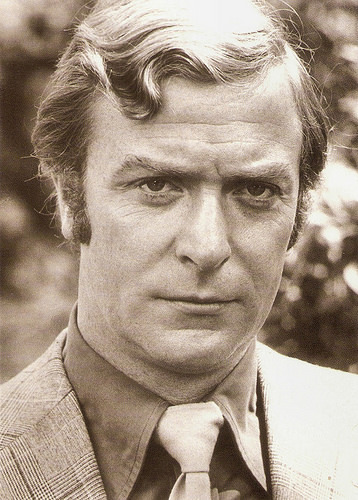
Modern postcard by Classic.
Trailer Get Carter (1971). Source: MOVIECLIPS Classic Trailers (YouTube).
Ytailer Dressed to Kill (1980). Source: MOVIECLIPS Classic Trailers (YouTube).
Sources: Wikipedia and .

Yugoslavian postcard by Cik Razglednica.
The working-class bloke with glasses and a down-home accent
In 1930, Michael Caine was born Maurice Joseph Micklewhite in London, to Ellen Frances Marie Micklewhite-Burchell, a cook and charlady, and Maurice Joseph Micklewhite, a fish-market porter. He has two brothers. Younger brother Stanley Caine appeared in at least three of Caine's films: Billion Dollar Brain (1967), Play Dirty (1969) and The Italian Job (1969). He did not know about his elder half-brother David until their mother died in 1989. For more than forty years, Caine's mother had paid periodic visits to a ‘cousin’ in a mental hospital. David suffered from epilepsy and lived till his death in 1992 in the hospital.
Michael left school at 15 and took a series of working-class jobs before joining the British army and serving in Korea during the Korean War, where he saw combat. Upon his return to England the 20-years-old Caine gravitated toward the theatre and got a job as an assistant stage manager. He adopted the name of Caine on the advice of his agent, taking it from a marquee of the Odeon Cinema that advertised The Caine Mutiny (Edward Dmytryk, 1954).
In the years that followed he worked in more than 100 television dramas, with repertory companies throughout England and eventually in Lindsay Anderson's West End staging of Willis Hall's The Long and the Short and the Tall (1959). He was Peter O'Toole 's understudy in that stage hit and took over the role when O'Toole left to make Lawrence of Arabia (David Lean, 1962).
Caine's first film role was as one of the privates in Stanley Baker 's platoon in the British war film A Hill in Korea (Julien Amyes, 1956). A big break came for Caine when he was cast in the Cockney stage comedy Next Time I'll Sing To You (1963). He was visited backstage by Stanley Baker , the star of A Hill in Korea, who asked him for his upcoming film Zulu, a film Baker was producing and starring in. Zulu (Cy Endfield, 1964) is the epic retelling of a historic 19th-century battle in South Africa between British soldiers and Zulu warriors. Instead of being typecast as a low-ranking Cockney soldier, he played a snobbish, aristocratic officer.
Zulu was a major success, but it was the role of the spy Harry Palmer in The Ipcress File (Sidney J. Furie, 1965) and the young womanizer in Alfie (Lewis Gilbert, 1966) that made Caine a major star. He epitomized the new breed of actor in mid-1960s England, the working-class bloke with glasses and a down-home accent.
Some excellent films followed including his American debut Gambit (Ronald Neame, 1966) with Shirley MacLaine, the Harry Palmer spy film Funeral in Berlin (Guy Hamilton, 1966), the caper The Italian Job (Peter Collinson, 1969) with Noël Coward, Battle of Britain (Guy Hamilton, 1969), and especially the crime film Get Carter (Mike Hodges, 1971) and the mystery thriller Sleuth (Joseph L. Mankiewicz, 1972) with Laurence Olivier , for which he earned his second Oscar nomination.

Spanish postcard by Productos Compactos S.A. Photo: publicity still for The Ipcress File (Sidney J. Furie, 1965).

British postcard by Boomerang. Photo: Everett Collection.
What's it all about?
During the bigger part of the 1970s, Michael Caine seemed to take on roles in below-average films, simply for the money he could by then command. There were some gems amongst the dross, however. He gave a magnificent performance opposite Sean Connery in The Man Who Would Be King (John Huston, 1975) and turned in a solid one as the commander of a Luftwaffe paratroop unit planning to kidnap Winston Churchill in The Eagle Has Landed (John Sturges, 1976). Caine also was part of an all-star cast in A Bridge Too Far (Richard Attenborough, 1977), was part of the ensemble in the comedy California Suite (Herbert Ross, 1978), and slashed Angie Dickenson in the thriller Dressed to Kill (Brian De Palma, 1980).
Highlights during the 1980s were Educating Rita (Lewis Gilbert, 1983), earning him the BAFTA and Golden Globe Award for Best Actor, and Hannah and Her Sisters (Woody Allen, 1986), for which he won his first Oscar for Best Supporting Actor. He was not present at the Academy Awards ceremony because he was filming Jaws: The Revenge (Joseph Sargent, 1987), for which he was nominated for worst supporting actor at the 1988 Razzie awards.
His other successful films were the war film Escape to Victory (John Huston, 1981), the Ira Levin thriller Deathtrap (Sidney Lumet, 1982), and the beautiful neo-noir mystery Mona Lisa (Neil Jordan, 1986) with Bob Hoskins. Caine was excellent as Ebenezer Scrooge in The Muppet Christmas Carol (Brian Henson, 1992). In 1992, he also published the autobiography What's it all about? It was a decade later followed by The Elephant to Hollywood (2012). He was awarded the CBE (Commander Of The Order Of The British Empire) in the 1993 Queen's Honours List for his services to drama.
Having by that time practically retired from acting on the big screen, he enjoyed a career resurgence in the late 1990s. He received a Golden Globe Award for his performance in the musical Little Voice (Mark Herman, 1998) and his second Academy Award for Best Supporting Actor for The Cider House Rules (Lasse Hallström, 1999). In 2000, he was awarded a Knight Bachelor of the Order of the British Empire.
In the last decades, he often played mentors and father figures to younger characters in films. In every film Caine made with director Christopher Nolan, his character either assists, guides, trains or educates the protagonist. In The Prestige (2006), Caine portrayed a magician who teaches the main character the art of illusion. For Nolan’s Dark Knight trilogy - Batman Begins (2005), The Dark Knight (2008) and The Dark Knight Rises (2012) - Caine played the supporting and nurturing butler Alfred Pennyworth to Bruce Wayne aka Batman (Christian Bale). For Inception (2010), Caine depicted the father of the main protagonist, Cobb, and aids him by recruiting one of his students. In Interstellar (2014), Caine portrays a professor/engineer, who invites and encourages the central character, Cooper, to lead an important space mission that will determine the future of planet earth.
Among his other more recent films that have been widely acclaimed are the British/German drama Last Orders (Fred Schepisi, 2001) with Tom Courtenay, the parody Austin Powers in Goldmember (Jay Roach, 2002) as Austin’s father, the Graham Greene adaptation The Quiet American (Phillip Noyce, 2002) with Brendan Fraser, Children of Men (Alfonso Cuarón, 2006) and Pixar's Cars 2 (John Lasseter, 2011). In the remake of Sleuth (Kenneth Branagh, 2007), Caine took over the role Laurence Olivier played in the 1972 version and Jude Law played Caine's original role.
Michael Caine married twice. In 1955, he married his first wife Patricia Haines. They divorced in 1958 and have one child, Dominique (aka Nikki). His current wife is Shakira Caine, whom he married in 1973. They have one daughter, Natasha. Caine has he has a granddaughter and two grandsons.

Modern postcard by Classic.
Trailer Get Carter (1971). Source: MOVIECLIPS Classic Trailers (YouTube).
Ytailer Dressed to Kill (1980). Source: MOVIECLIPS Classic Trailers (YouTube).
Sources: Wikipedia and .
Published on May 21, 2015 22:00
May 20, 2015
Peggy Hyland
Pretty brunette Peggy Hyland (1884–1973) was an English film actress and director, who starred in more than 45 British and American silent films. She remained active in films until 1925.
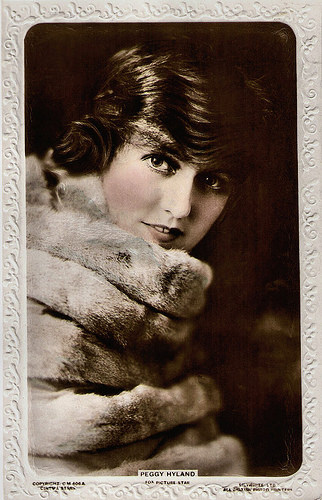
British postcard in the Lilywhite Photographic series. Photo: William Fox.
The Love of an Actress
Peggy Hyland was born Gladys Lucy Hutchinson in Harborne a suburb of Birmingham, in 1884. She was educated in Britain and at convents in Europe. The first convent she attended was Seroule in Verviers, on the frontier of Belgium.
In 1910, she began to act on stage, according to Wikipedia after consulting a seer who foretold her great success. She toured with legendary stage actor Cyril Maude in the play The Yellow Jacket.
Hyland began her screen career in 1912. Women and British Cinema (WSBC) mentions as her first film the Clarendon production The Love of an Actress (Wilfred Noy, 1914). According to Paul Rothwell-Smith at IMDb , she made her film debut for the Neptune Film Co. in In the Rank (Percy Nash, 1914) starring Gregory Scott.
That year, she also married her first husband, Owen Grant Evan-Thomas. The next year, she starred for G.B. Samuelson Productions in the drama John Halifax, Gentleman (George Pearson, 1915). She played Ursula March opposite Fred Paul in the title role. For Samuelson, she also appeared in Infelice (L.C. MacBean, Fred Paul, 1915) with Fred Paul and Queenie Thomas.
In the following year, she reunited with George Pearson for the romance Sally Bishop (George Pearson, 1916) starring Marjorie Villis and Aurelio (or Aurele) Sidney .
Between 1916 and 1920 she was based in America working for Fox, Vitagraph and Famous Players. For Vitagraph, she co-starred with E.H. Sothern in The Chattel (Fred Thomson, 1916) and appeared as Olette in The Sixteenth Wife (Charles Brabin, 1917). Opposite Antonio Moreno, she played in the drama Her Right to Live (Paul Scardon, 1917) as the head of a of a family of orphaned children destined for the poorhouse.
The Moving Picture World in 1917: “In selecting a cast for Her Right to Live, the five-reel Vitagraph Blue Ribbon Feature written by Paul West, the man in charge has had the courage to give Peggy Hyland the part of a heroine of the most pronounced soubrette type. All the stage tricks that tradition has bequeathed to the simple but roguish village maiden, are to be expected in the character of Polly Biggs. The star of Her Right to Live discards them entirely and makes the orphan girl a natural human being with a bright sunny nature, and an innocence that is not more wise than nice.”
In the Fox Film drama Debt of Honour (O.A.C. Lund, 1918), Hyland sacrifices her good name to shield the reputation of a U.S. Senator who has taken her in his home as an orphan. Perhaps her best known film was the Fox production The Merry-Go-Round (Edmund Lawrence, 1919) in which she played both a Gypsy and heroin Susie Alice Pomeroy opposite Jack Mulhall. Newspapers of the era described her double role in this romance as one of the actress' best performances. The crime film Black Shadows (Howard M. Mitchell, 1920) was another Fox Film feature in which Peggy portrayed Marjorie Langdon, a victim of hypnotism who begins to have compulsions to steal.
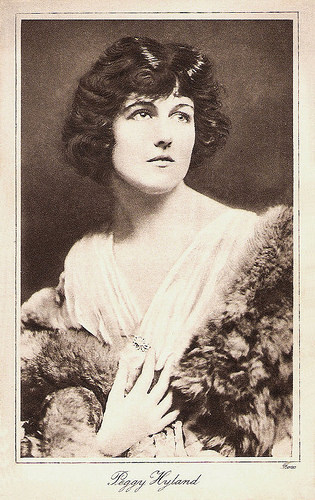
British postcard. Photo: Fox.
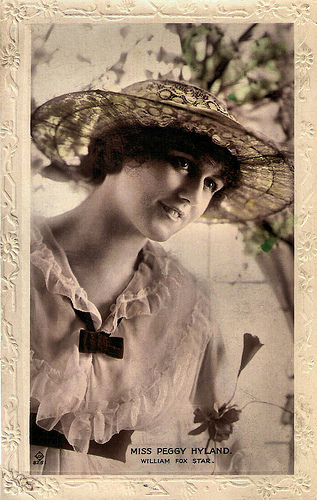
British postcard in Valentine's Real Photograph series, no. 8251. Photo: William Fox.
Producer and director
Peggy Hyland's film credits number more than forty-five, in both British and American productions. Back in England, Australian Fred Leroy Granville directed her for G.B. Samuelson Productions in films like the romances The Honeypot (1920) with Lillian Hall-Davis , and the sequel Love Maggy (1921) with James Lindsay. The Australian director became her husband, but also this second marriage later would end in a divorce.
She also starred in the comedy Mr. Pim Passes By (Albert Ward, 1921) with Henry Kendall. It was based on the 1919 play of the same title by A.A. Milne. In 1922 Hyland told in Kinematograph Weekly that a woman was ‘as capable a director as a man’ and hoped to prove the truth of this assertion with a series of two reel comedies she was to direct.
Hyland wrote, produced, directed and starred in With Father's Help (Peggy Hyland, 1922) and she directed and starred in The Haunted Pearls (Peggy Hyland, 1924), according to Paul Rothwell-Smith at IMDb , although there is no lemma of this film on IMDb .
In 1923, she was back in the U.S. to star in the Arabian adventure Shifting Sands (Fred Leroy Granville, 1923). She stopped making films in 1925. Her final film was the British adventure film Forbidden Cargoes (Fred LeRoy Granville, 1926).
There is only little information about her later life. Wikipedia : “The date of death for Hyland has not been definitively determined. The last whereabouts of her was her marriage to Universal film producer Fred LeRoy Granville in September 1921. (...) She may have after the divorce from Granville reverted to her birth name to allow a clean exit from the film industry. A search of the Find a Grave database, non-famous section, yields no Peggy Hyland (August 2010). However there are several Gladys Hutchinsons, one of whose date of birth is unknown and who apparently died in England in 1944 during World War II and was possibly a casualty of an air raid.”
IMDb notes that Peggy Hyland died in 1973 at the age of 88 in Tonbridge, England, UK.
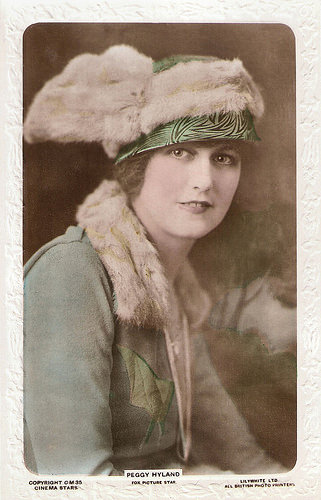
British postcard in the Lilywhite Photographic series. Photo: Fox.
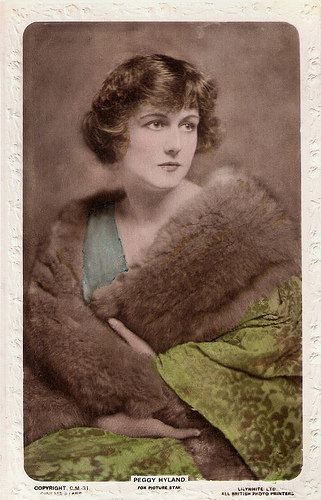
British postcard in the Lilywhite Photographic series. Photo: William Fox.
Sources: (IMDb), Women and British Cinema, Wikipedia and .

British postcard in the Lilywhite Photographic series. Photo: William Fox.
The Love of an Actress
Peggy Hyland was born Gladys Lucy Hutchinson in Harborne a suburb of Birmingham, in 1884. She was educated in Britain and at convents in Europe. The first convent she attended was Seroule in Verviers, on the frontier of Belgium.
In 1910, she began to act on stage, according to Wikipedia after consulting a seer who foretold her great success. She toured with legendary stage actor Cyril Maude in the play The Yellow Jacket.
Hyland began her screen career in 1912. Women and British Cinema (WSBC) mentions as her first film the Clarendon production The Love of an Actress (Wilfred Noy, 1914). According to Paul Rothwell-Smith at IMDb , she made her film debut for the Neptune Film Co. in In the Rank (Percy Nash, 1914) starring Gregory Scott.
That year, she also married her first husband, Owen Grant Evan-Thomas. The next year, she starred for G.B. Samuelson Productions in the drama John Halifax, Gentleman (George Pearson, 1915). She played Ursula March opposite Fred Paul in the title role. For Samuelson, she also appeared in Infelice (L.C. MacBean, Fred Paul, 1915) with Fred Paul and Queenie Thomas.
In the following year, she reunited with George Pearson for the romance Sally Bishop (George Pearson, 1916) starring Marjorie Villis and Aurelio (or Aurele) Sidney .
Between 1916 and 1920 she was based in America working for Fox, Vitagraph and Famous Players. For Vitagraph, she co-starred with E.H. Sothern in The Chattel (Fred Thomson, 1916) and appeared as Olette in The Sixteenth Wife (Charles Brabin, 1917). Opposite Antonio Moreno, she played in the drama Her Right to Live (Paul Scardon, 1917) as the head of a of a family of orphaned children destined for the poorhouse.
The Moving Picture World in 1917: “In selecting a cast for Her Right to Live, the five-reel Vitagraph Blue Ribbon Feature written by Paul West, the man in charge has had the courage to give Peggy Hyland the part of a heroine of the most pronounced soubrette type. All the stage tricks that tradition has bequeathed to the simple but roguish village maiden, are to be expected in the character of Polly Biggs. The star of Her Right to Live discards them entirely and makes the orphan girl a natural human being with a bright sunny nature, and an innocence that is not more wise than nice.”
In the Fox Film drama Debt of Honour (O.A.C. Lund, 1918), Hyland sacrifices her good name to shield the reputation of a U.S. Senator who has taken her in his home as an orphan. Perhaps her best known film was the Fox production The Merry-Go-Round (Edmund Lawrence, 1919) in which she played both a Gypsy and heroin Susie Alice Pomeroy opposite Jack Mulhall. Newspapers of the era described her double role in this romance as one of the actress' best performances. The crime film Black Shadows (Howard M. Mitchell, 1920) was another Fox Film feature in which Peggy portrayed Marjorie Langdon, a victim of hypnotism who begins to have compulsions to steal.

British postcard. Photo: Fox.

British postcard in Valentine's Real Photograph series, no. 8251. Photo: William Fox.
Producer and director
Peggy Hyland's film credits number more than forty-five, in both British and American productions. Back in England, Australian Fred Leroy Granville directed her for G.B. Samuelson Productions in films like the romances The Honeypot (1920) with Lillian Hall-Davis , and the sequel Love Maggy (1921) with James Lindsay. The Australian director became her husband, but also this second marriage later would end in a divorce.
She also starred in the comedy Mr. Pim Passes By (Albert Ward, 1921) with Henry Kendall. It was based on the 1919 play of the same title by A.A. Milne. In 1922 Hyland told in Kinematograph Weekly that a woman was ‘as capable a director as a man’ and hoped to prove the truth of this assertion with a series of two reel comedies she was to direct.
Hyland wrote, produced, directed and starred in With Father's Help (Peggy Hyland, 1922) and she directed and starred in The Haunted Pearls (Peggy Hyland, 1924), according to Paul Rothwell-Smith at IMDb , although there is no lemma of this film on IMDb .
In 1923, she was back in the U.S. to star in the Arabian adventure Shifting Sands (Fred Leroy Granville, 1923). She stopped making films in 1925. Her final film was the British adventure film Forbidden Cargoes (Fred LeRoy Granville, 1926).
There is only little information about her later life. Wikipedia : “The date of death for Hyland has not been definitively determined. The last whereabouts of her was her marriage to Universal film producer Fred LeRoy Granville in September 1921. (...) She may have after the divorce from Granville reverted to her birth name to allow a clean exit from the film industry. A search of the Find a Grave database, non-famous section, yields no Peggy Hyland (August 2010). However there are several Gladys Hutchinsons, one of whose date of birth is unknown and who apparently died in England in 1944 during World War II and was possibly a casualty of an air raid.”
IMDb notes that Peggy Hyland died in 1973 at the age of 88 in Tonbridge, England, UK.

British postcard in the Lilywhite Photographic series. Photo: Fox.

British postcard in the Lilywhite Photographic series. Photo: William Fox.
Sources: (IMDb), Women and British Cinema, Wikipedia and .
Published on May 20, 2015 22:00
Paul van Yperen's Blog
- Paul van Yperen's profile
- 13 followers
Paul van Yperen isn't a Goodreads Author
(yet),
but they
do have a blog,
so here are some recent posts imported from
their feed.



